Are you seeing everywhere to find Go Math Grade 4 Answer Key Chapter 3 Multiply 2-Digit Numbers in pdf? If so, you have stepped onto the right page. On this page, we have compiled a pdf formatted HMH Go Math Grade 4 Chapter 3 Multiply 2-Digit Numbers Answer Key. Take the help of the Go Math Grade 4 Solution Key during your practice sessions and clear your queries. Assess your preparation standards and concentrate on the areas you are flagging.
Go Math Grade 4 Solution Key Pdf Chapter 3 Multiply 2-Digit Numbers
With the help of HMH Go Math Grade 4 Answer Key Ch 3, you can learn the easy methods to solve problems. Answer Key for HMH Go Math Grade 4 Chapter 3 Multiply 2-Digit Numbers consists of all the questions from practice tests, exercises, assessments tests. You guys are recommended to solve the 4th grade Go Math Answers of Chapter 3 Multiply 2-Digit Numbers regularly & attempt the exams with confidence. The topics covered in the Go Math HMH grade 4 Solutions are designed perfectly & in an understandable way.
Lesson 1: Multiply by Tens
Lesson 2: Estimate Products
- Estimate Products – Page No. 153
- Estimate Products Lesson Check – Page No. 154
- Estimate Products Lesson Check 1 – Page No. 155
- Estimate Products Lesson Check 2 – Page No. 156
Lesson 3: Investigate • Area Models and Partial Products
- Area Models and Partial Products – Page No. 159
- Area Models and Partial Products Lesson Check – Page No. 160
- Area Models and Partial Products Lesson Check 1 – Page No. 161
- Area Models and Partial Products Lesson Check 2 – Page No. 162
Lesson 4: Multiply Using Partial Products
- Multiply Using Partial Products – Page No. 165
- Multiply Using Partial Products – Page No. 166
- Multiply Using Partial Products Lesson Check – 167
- Multiply Using Partial Products Lesson Check 1 – 168
Mid-Chapter Checkpoint
- Mid-Chapter Checkpoint – Page No. 169
- Mid-Chapter Checkpoint Lesson Check – Page No. 170
- Mid-Chapter Checkpoint Lesson Check 1 – Page No. 173
- Mid-Chapter Checkpoint Lesson Check 2 – Page No. 174
Lesson 5: Multiply with Regrouping
Lesson 6: Choose a Multiplication Method
- Choose a Multiplication Method – Page No. 179
- Choose a Multiplication Method Lesson Check – Page No. 180
- Choose a Multiplication Method Lesson Check 1 – Page No. 181
- Choose a Multiplication Method Lesson Check 2 – Page No. 182
Lesson 7: Problem Solving • Multiply 2-Digit Numbers
- Multiply 2-Digit Numbers – Page No. 185
- Multiply 2-Digit Numbers Lesson Check – Page No. 186
- Multiply 2-Digit Numbers Lesson Check 1 – Page No. 187
- Multiply 2-Digit Numbers Lesson Check 2 – Page No. 188
Review/Test
- Review/Test – Page No. 189
- Review/Test – Page No. 190
- Review/Test – Page No. 191
- Review/Test – Page No. 192
- Review/Test – Page No. 193
- Review/Test – Page No. 194
- Review/Test – Page No. 199
- Review/Test – Page No. 200
Common Core – Page No. 149
Multiply by Tens
Choose a method. Then find the product.
Question 1.
16 × 60 = 960
Use the halving-and-doubling strategy.
Find half of 16: 16 ÷ 2 = 8.
Multiply this number by 60: 8 × 60 = 480
Double this result: 2 × 480 = 960
Answer:
960
Explanation:
Use the halving-and-doubling strategy.
Find half of 16: 16 ÷ 2 = 8.
Multiply this number by 60: 8 × 60 = 480
Double this result: 2 × 480 = 960
Question 2.
80 × 22 = ______
Answer:
1760
Explanation:
By using the place value method, Multiply 80 x 22
You can think of 80 as 8 tens
80 x 22 = (22 x 8) tens
= 176 tens
= 176 x 10 = 1760
80 x 22 = 1760
Question 3.
30 × 52 = ______
Answer:
1560
Explanation:
Use the Associative Property
You can think of 30 as 3 x 10
30 x 52 = (3 x 10) x 52
= 3 x (10 x 52)
= 3 x 520
= 1560
30 x 52 = 1560
Question 4.
60 × 20 = ______
Answer:
1200
Explanation:
60 x 20
Use the halving and doubling strategy
half of the 60 to make the problem simpler
60/ 2 = 30
Multiply 30 with 20
30 x 20 = 600
Double the 600
2 x 600= 1200
60 x 20 = 1200
Question 5.
40 × 35 = ______
Answer:
1400
Explanation:
By using the Associative Property 40 x 35
You can think of 40 as 4 x 10
40 x 35 = (4 x 10) x 35
= 4 x (10 x 35)
= 4 x 350
= 1400
40 x 35 = 1400
Question 6.
10 × 90 = ______
Answer:
900
Explanation:
By using the place value method, Multiply 10 x 90
You can think of 90 as 9 tens
10 x 90 = (10 x 9) tens
= 90 tens
= 10 x 90 = 900
Question 7.
31 × 50 = ______
Answer:
1,550
Explanation:
Use the place value method to multiply 31 x 50
You can think of 50 as 5 tens
31 x 50 = 31 x 5 tens
= 155 tens
= 1,550
31 x 50 = 1,550
Problem Solving
Question 8.
Kenny bought 20 packs of baseball cards. There are 12 cards in each pack. How many cards did Kenny buy?
______ cards
Answer:
240 cards
Explanation:
From the given data,
Kenny bought 20 packs of basketball cards
There are 12 cards in each pack = 12 x 20 cards
Use the associative property
You can write 20 as 2 x 10
12 x 20 = 12 x (2 x 10)
= (12 x 2) x 10
= (24) x 10
= 240 cards
Kenny bought 240 cards
Question 9.
The Hart family drove 10 hours to their vacation spot. They drove an average of 48 miles each hour. How many miles did they drive in all?
______ miles
Answer:
480 miles
Explanation:
As per the given data,
Hart family drove 10 hours to their vacation spot
Average speed per each hour is = 48 miles
Total miles = 48 x 10
Use the halving and doubling strategy
Half of the 48 to make the problem simpler
48/ 2 = 24
Multiply 24 with 10 = 24x 10 = 240
Double the value = 2 x 240 = 480 miles
Total miles drove by hart family = 480 miles.
Common Core – Page No. 150
Lesson Check
Question 1.
For the school play, 40 rows of chairs are set up. There are 22 chairs in each row. How many chairs are there in all?
Options:
a. 800
b. 840
c. 880
d. 8,800
Answer:
c. 880
Explanation:
As per the given data
For the school play, 40 rows of chairs are available. 22 chairs are available in each row.
Then total chairs in school play are = 22 x 40
By using the place value method
You can think of 40 as 4 tens
22 x 40 = 22 x 4 tens
= 88 tens
= 880
Total chairs in school are = 880
Question 2.
At West School, there are 20 classrooms. Each classroom has 20 students. How many students are at West School?
Options:
a. 40
b. 400
c. 440
d. 4,000
Answer:
b. 400
Explanation:
From the given data,
Total classrooms in west school = 20
Number of students per each classroom = 20
Then, total students at West School = 20 x 20
By using the associative property
You can think of 20 as 2 x 10
20 x 20 = 20 x (2 x 10)
= (20 x 2) x 10
=(40) x 10
=400
Total number of students at West School = 400
Spiral Review
Question 3.
Alex has 48 stickers. This is 6 times the number of stickers Max has. How many stickers does Max have?
Options:
a. 6
b. 7
c. 8
d. 9
Answer:
c. 8
Explanation:
As per the give data,
Alex has 48 stickers
That means, X= 48
This is 6 times the number of stickers max has = Y = 6X = 48
Then, number of stickers with Max = Y = X = 48/6 = 8
Number of stickers with Max = Y = 8 Stickers.
Question 4.
Ali’s dog weighs 8 times as much as her cat. Together, the two pets weigh 54 pounds. How much does Ali’s dog weigh?
Options:
a. 6 pounds
b. 42 pounds
c. 46 pounds
d. 48 pounds
Answer:
d. 48 pounds
Explanation:
From the given data,
Ali’s cat weight = X
Ali’s dog weight = 8 times as much as Ali’s cat = 8X
Together, the two pets weight = (X+8X) = 54 pounds
= 9X = 54 pounds
= X = 54/9 pounds = 6 pounds
Then, Ali’s dog weight = 8X =8 x 6 = 48 pounds.
Question 5.
Allison has 3 containers with 25 crayons in each. She also has 4 boxes of markers with 12 markers in each box. She gives 10 crayons to a friend. How many crayons and markers does Allison have now?
Options:
a. 34
b. 113
c. 123
d. 133
Answer:
b. 113
Explanation:
As per the given data,
Allison has 3 containers with 25 crayons in each = X = 3 x 25 = 75
Allison has 4 boxes of markers with 12 markers in each box = Y = 4 x 12 = 48
Allison gives 10 crayons to a friend = Z = 75-10 = 65
Now, total number of crayons and markers with Allison = Y + Z = 48 + 65 = 113
Question 6.
The state of Utah covers 82,144 square miles. The state of Montana covers 145,552 square miles. What is the total area of the two states?
Options:
a. 63,408 square miles
b. 223,408 square miles
c. 227,696 square miles
d. 966,992 square miles
Answer:
c. 227,696 square miles
Explanation:
From the given data,
The state of Utah covers 82,144 square miles
The state of Montana covers 145,552 square miles
Then, Total area of the two states = 82,144 + 145,552
The total area of two states = 227,696 square miles.
Page No. 153
Question 1.
To estimate the product of 62 and 28 by rounding, how would you round the factors? What would the estimated product be?
about _____
Answer:
1800
Explanation:
By using rounding and mental math
Estimate 62 x 28
Firstly, round each factor
62 x 28
![]()
![]()
60 x 30
Use mental math
6 x 3 = 18
60 x 30 = 1800
So, estimated product of 62 and 28 = 1800
Estimate the product. Choose a method.
Question 2.
96 × 34
Estimate: _____
Answer:
3000
Explanation:
Use mental math and compatible numbers
96 x 34
![]()
![]()
100 x 30
Use mental math
1 x 30 = 30
100 x 30= 3000
Question 3.
47 × $39
Estimate: $ _____
Answer:
2000
Explanation:
Round to the nearest ten
47 x $39
![]()
![]()
50 x $40
50 x $ 4 = $200
50 x $40 = 2000
Question 4.
78 × 72
Estimate: _____
Answer:
5600
Explanation:
Use rounding and mental math
Round each factor
78 x 72
![]()
![]()
80 x 70
Use mental math
8 x 7 = 56
80 x 70 = 5600
Question 5.
41 × 78
Estimate: _____
Answer:
3200
Explanation:
Use compatible numbers and mental math
41 x 78
![]()
![]()
40 x 80
Use mental math
40 x 8 = 320
40 x 80 = 3200
Question 6.
51 × 73
Estimate: _____
Answer:
3500
Explanation:
Round to the nearest ten
51 x 73
![]()
![]()
50 x 70 = 3500
Question 7.
34 × 80
Estimate: _____
Answer:
2400
Explanation:
Round each factor
34 x 80
![]()
![]()
30 x 80
3 x 8 = 240
30 x 80 = 2400
Practice: Copy and Solve Estimate the product. Choose a method.
Question 8.
61 × 31
Estimate: _____
Answer:
1800
Explanation:
Round to the nearest ten
61 x 31
![]()
![]()
60 x 30 = 1800
Question 9.
52 × 68
Estimate: _____
Answer:
3500
Explanation:
Round each factor
52 x 68
![]()
![]()
50 x 70
Use mental math
5 x 7 =35
50 x 70 = 3500
Question 10.
26 × 44
Estimate: _____
Answer:
1200
Explanation:
Round to the nearest tens
26 x 44
![]()
![]()
30 x 40 = 1200
Question 11.
57 × $69
Estimate: $ _____
Answer:
$4200
Explanation:
Round each factor
57 x $69
![]()
![]()
60 x $70
Use mental math
6 x $7 = $42
60 x $70 = $4200
Find two possible factors for the estimated product.
Question 12.
2,800
Type below:
___________
Answer:
2800
Explanation:
Let us consider 7 x 4 = 28
70 x 40 = 2800
Question 13.
8,100
Type below:
___________
Answer:
8,100
Explanation:
Let us take 9 x 9 = 81
90 x 90 = 8,100
Question 14.
5,600
Type below:
___________
Answer:
5,600
Explanation:
Let us consider 7 x 8 = 56
70 x 80 = 5,600
Question 15.
2,400
Type below:
___________
Answer:
2,400
Explanation:
Let us take 4 x 6 = 24
40 x 60 = 2400
Or 3 x 8 = 24
30 x 80 = 2,400
Question 16.
Mr. Parker jogs for 35 minutes each day. He jogs 5 days in week 1, 6 days in week 2, and 7 days in week 3. About how many minutes does he jog?
about _____ minutes
Answer:
about 630 minutes
Explanation:
From the given data,
Mr. Parker jogs per day = 35 minutes
He jogs 5 days in week 1 = 5 x 35 = 175 minutes
6 days in week 2 = 6 x 35 = 210 minutes
7 days in week 3 = 7 x 35 = 245 minutes
Total minutes of jog by Mr. Parker = week 1 + week 2 + week 3
= 175 + 210 + 245
= 630 minutes
So, total minutes of jog by Mr. Parker = 630 minutes
Question 17.
There are 48 beads in a package. Candice bought 4 packages of blue, 9 packages of gold, 6 packages of red, and 2 packages of silver beads. About how many beads did Candice buy?
about _____ beads
Answer:
about 1008 beads
Explanation:
As per the given data,
48 beads are there in a package
Candice bought 4 packages of blue beads = 4 x 48 = 192
9 packages of gold beads = 9 x 48 = 432
6 packages of red beads = 6 x 48 = 288
2 packages of silver beads = 2 x 48 = 96
Total beads bought by Candice = 192 + 432 + 288 + 96
= 1008 beads
So, total beads bought by Candice = 1008.
Page No. 154
Question 18.
On average, a refrigerator door is opened 38 times each day. Len has two refrigerators in his house. Based on this average, about how many times in a 3-week period are the refrigerator doors opened?
about _____ times
Answer:
about 1600 times
Explanation:
From the given data,
On average, a refrigerator door is opened per day = 38 times
3-week period = 7 x 3 = 21
Then, a refrigerator door is opened per 21 days = 21 x 38 = 798 times
Len has 2 refrigerators in his house
Then, two refrigerators door are opened per 21 days = 2 x 798
= 1596 times
So, in a 3 – week period refrigerator door is opened about 1600 times
Question 19.
The cost to run a refrigerator is about $57 each year. About how much will it have cost to run by the time it is 15 years old?
about $ _____
Answer:
1200
Explanation:
As per the data,
The cost to run a refrigerator per each year = $57
Cost to run a refrigerator by the time it is 15 years old = $57 * 15
Round to the nearest tens
$57 x 15
![]()
![]()
$60 x 20
Use mental math
$6 x 2 = 12
$ 60 x 20 = 1200
Question 20.
If Mel opens his refrigerator door 36 times every day, about how many times will it be opened in April? Will the exact answer be more than or less than the estimate? Explain.
Type below:
___________
Answer:
1200
Explanation:
From the given data,
Mel opens his refrigerator door per day = 36 times
Number of days in April month = 30 days
Refrigerator door opened in April month = 36 * 30
Round the factors
36 x 30
![]()
![]()
40 x 30 = 1200
Question 21.
Represent a Problem What question could you write for this answer? The estimated product of two numbers, that are not multiples of ten, is 2,800.
Type below:
___________
Answer:
2800
Explanation:
Let us take
1.
38 × 21
↓ ↓
40 × 20 = 800
2,800 = 42 x 68
↓ ↓
40 x 70 = 2800
Question 22.
Which is a reasonable estimate for the product? Write the estimate. An estimate may be used more than once.

26 × 48 __________
28 × 21 __________
21 × 22 __________
51 × 26 __________
Answer:
25 x 50 = 1250
30 x 20 = 600
20 x 20 = 400
50 x 25 = 1250
Explanation:
26 x 48 -> 25 x 50 = 1250
28 x 21 -> 30 x 20 = 600
21 x 22 -> 20 x 20 = 400
51 x 26 -> 50 x 25 = 1250
Common Core – Page No. 155
Estimate Products
Estimate the product. Choose a method.
Question 1.
38 × 21
38 × 21
↓ ↓
40 × 20
800
Answer:
800
Explanation:
38 × 21
↓ ↓
40 × 20
800
Question 2.
63 × 19
Estimate: _____
Answer:
1200
Explanation:
63 x 19
![]()
![]()
60 x 20 = 1200
Estimated product of 63 x 19 = 1200
Question 3.
27 × $42
Estimate: $ _____
Answer:
$1000
Explanation:
27 × $42
![]()
![]()
25 x $40 = $1000
Estimated Product of 25 x $ 42 = $1000
Question 4.
73 × 67
Estimate: _____
Answer:
4900
Explanation:
73 × 67
![]()
![]()
70 x 70 = 4900
Estimated Product of 73 x 67 = 4900
Question 5.
37 × $44
Estimate:$ _____
Answer:
$1600
Explanation:
37 × $44
![]()
![]()
40 x $40 = $1600
Estimated Product of 37 x $44 = $1600
Question 6.
85 × 71
Estimate: _____
Answer:
6300
Explanation:
85 × 71
![]()
![]()
90 x 70 = 6300
Estimated Product of 85 x 71 = 6300
Question 7.
88 × 56
Estimate: _____
Answer:
4950
Explanation:
88 × 56
![]()
![]()
90 x 55 = 4950
Estimated Product of 90 x 55 = 4950
Question 8.
97 × 13
Estimate: _____
Answer:
1,000
Explanation:
97 × 13
![]()
![]()
100 x 10 = 1,000
Question 9.
92 × 64
Estimate: _____
Answer:
5850
Explanation:
92 × 64
![]()
![]()
90 x 65 = 5850
Problem Solving
Question 10.
A dime has a diameter of about 18 millimeters. About how many millimeters long would a row of 34 dimes be?
about _____ millimeters
Answer:
about 600 millimeters
Explanation:
From the given data,
A dime has a diameter of about 18 millimeters
Then, 34 dimes diameter = 18 * 34
18 x 34
![]()
![]()
20 x 30 = 600
So, 34 dimes have a diameter of about 600 millimeters long
Question 11.
A half-dollar has a diameter of about 31 millimeters. About how many millimeters long would a row of 56 half-dollars be?
about _____ millimiters
Answer:
1800 millimeters
Explanation:
As per the given data,
A half – dollar has a diameter of about 31 millimeters
Then, 56 half-dollars diameter = 31 * 56
31 * 56
![]()
![]()
30 * 60
So, 56 half-dollars have a diameter of about 1800 millimeters long.
Common Core – Page No. 156
Lesson Check
Question 1.
Which is the best estimate for the product
43 × 68?
Options:
a. 3,500
b. 2,800
c. 2,400
d. 280
Answer:
b. 2,800
Explanation:
Round to the nearest tens
43 x 68
![]()
![]()
40 x 70
Use mental math
4 x 7 = 28
40 x 70 = 2800
Estimated product of 43 x 68 = 2800
Question 2.
Marissa burns 93 calories each time she plays fetch with her dog. She plays fetch with her dog once a day. About how many calories will Marissa burn playing fetch with her dog in 28 days?
Options:
a. 4,000
b. 2,700
c. 2,000
d. 270
Answer:
b. 2,700
Explanation:
From the given data,
Marissa burned calories each time when she plays fetch with her dog= 93 calories
Then, Marissa burned calories in 28 days while playing fetch with her dog = 28 x 93
Round to the nearest tens
28 x 93
![]()
![]()
30 x 90
Then, estimated burned calories in 28 days by Marissa = 2700 calories
Spiral Review
Question 3.
Use the model to find 3 × 126.

Options:
a. 368
b. 378
c. 468
d. 478
Answer:
b. 378
Explanation:
From the above Figure,
3 x 126 = 3 x 100 + 3 x 20 + 3 x 6
= 300 + 60 + 18
= 378
3 x 126 = 378
Question 4.
A store sells a certain brand of jeans for $38. One day, the store sold 6 pairs of jeans of that brand. How much money did the store make from selling the 6 pairs of jeans?
Options:
a. $188
b. $228
c. $248
d. $288
Answer:
b. $228
Explanation:
As per the given data,
A store sells a certain brand of jeans for rupees = $38
One day, the store sold 6 pairs of jeans of that brand = 6 x $38
6 x $38 = $228
The total amount of 6 pairs of jeans = $228
Question 5.
The Gateway Arch in St. Louis, Missouri, weighs about 20,000 tons. Which amount could be the exact number of tons the Arch weighs?
Options:
a. 31,093 tons
b. 25,812 tons
c. 17,246 tons
d. 14,096 tons
Answer:
c. 17,246 tons
Explanation:
From the given data,
The Gateway Arch in St.Louis, Missouri weight = about 20,000 tons
From the available options, 17,246 tons is closer to 20,000 tons
Then, the exact number of tons the Arch weighs = 17,246 tons
Question 6.
Which is another name for 23 ten thousands?
Options:
a. 23,000,000
b. 2,300,000
c. 230,000
d. 23,000
Answer:
c. 230,000
Explanation:
As per the data,
Another name for 23 ten thousands = 23 x 10,000
= 230,000
Another name for 23 ten thousand = 2,30,000
Page No. 159
Find the product.
Question 1.
16 × 19
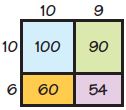
16 × 19 = _____
Answer:
304
Explanation:

16 x 19 = 304
Question 2.
18 × 26
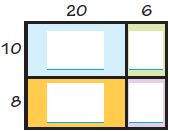
18 × 26 = _____
Answer:
468
Explanation:
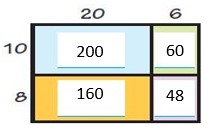
200 + 160 + 60 + 48 = 468
Question 3.
27 × 39
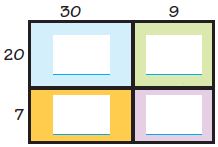
27 × 39 = ______
Answer:
1,053
Explanation:
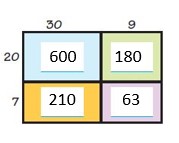
600 + 210 + 180 +63 = 1053
Draw a model to represent the product.
Then record the product.
Question 4.
14 × 16 = ______
Answer:
224
Explanation:
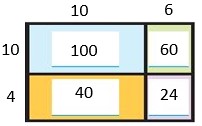
100 + 40 + 60 + 24 = 224
Question 5.
23 × 25 = ______
Answer:
575
Explanation:

400 + 60 + 100 + 15 = 575
Question 6.
Explain how modeling partial products can be used to find the products of greater numbers.
Type below:
__________
Answer:
You can use mental math to find the partial products and then find the sum of the partial products.
Explanation:
Question 7.
Emma bought 16 packages of rolls for a party. There were 12 rolls in a package. After the party there were 8 rolls left over. How many rolls were eaten? Explain.
______ rolls
Answer:
184 rolls were eaten
Explanation:
From the given data,
Emma bought 16 packages of rolls for a party
There were 12 rolls in a package
Then, total rolls = 16 x 12 = 192

100 + 60 + 20 + 12 =192
After the party there were 8 rolls left over
Then, total eaten rolls are = 192 – 8 = 184
Page No. 160
Question 8.
Jamal and Kim used different ways to solve 12 × 15 by using partial products. Whose answer makes sense? Whose answer is nonsense? Explain your reasoning.
Jamal’s Work
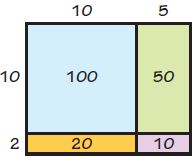
100 + 20 + 10 = 130
Kim’s Work

120 + 60 = 180
a. For the answer that is nonsense, write an answer that makes sense.
Type below:
__________
Answer:
a. Jamal’s work makes nonsense.
100 + 20 + 50 + 10 = 180 it makes sense
Question 8.
b. Look at Kim’s method. Can you think of another way Kim could use the model to find the product? Explain.
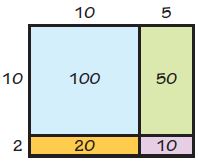
Type below:
__________
Answer:
Other method: 12 x 15
10 x 12 = 120
5 x 12 = 60
120 + 60 = 180.
Explanation:
Kim follows another method to find 12 x 15
That is, 100 + 50 = 150
20 + 10 = 30
Then, 150 + 30 =180
12 x 15 = 180
Question 9.
Look at the model in 8b. How would the partial products change if the product was 22 × 15? Explain why you think the products changed.
Type below:
__________
Answer:
330
Explanation:
Following the 8b method
22 x 15 =330
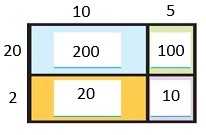
200 + 100 = 300
20 + 10 = 30
Now, 300 + 30 = 330
Finally, 22 x 15 = 330
The factor of 15 is increased in present problem. So, the product also increases for 15 x 22.
Common Core – Page No. 161
Area Models and Partial Products
Draw a model to represent the product.
Then record the product.
Question 1.
13 × 42

Answer:

Question 2.
18 × 34 = ______
Answer:

300 + 40 + 240 + 32 = 612
Question 3.
22 × 26 = ______
Answer:

400 + 120 + 40 + 12 = 572
Question 4.
1 5 × 33 = ______
Answer:
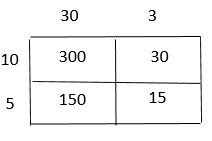
300 + 30 + 150 + 15 = 495
Question 5.
23 × 29 = ______
Answer:
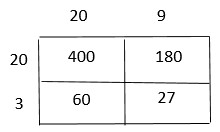
400 + 180 + 60 + 27 = 667
Question 6.
19 × 36 = ______
Answer:

300 + 60 + 270 + 54 = 684
Problem Solving
Question 7.
Sebastian made the following model to find the product 17 × 24.

Is his model correct? Explain.
a. yes
b. no
Answer:
b. no
Explanation:
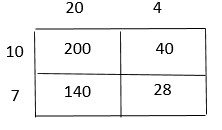
200 + 40 + 140 + 28 = 408
Question 8.
Each student in Ms. Sike’s kindergarten class has a box of crayons. Each box has 36 crayons. If there are 18 students in Ms. Sike’s class, how many crayons are
there in all?
______ crayons
Answer:
648 crayons
Explanation:
From the given information,
Each student in Ms.Sike’s kindergarten class has a box of crayons
Crayons in each box = 36 Crayons
Number of students in Mr.Sike’s class = 18 students
Total crayons = 18 x 36

300 + 60 + 240 + 48 = 648
Common Core – Page No. 162
Lesson Check
Question 1.
Which product does the model below represent?
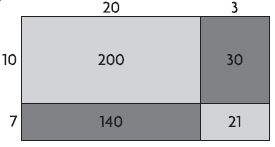
Options:
a. 161
b. 230
c. 340
d. 391
Answer:
d. 391
Explanation:
200 + 30 + 140 + 21 = 391
17 x 23 = 391
Question 2.
Which product does the model below represent?
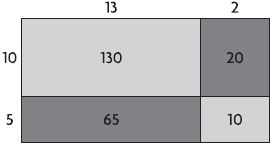
Options:
a. 219
b. 225
c. 244
d. 275
Answer:
b. 225
Explanation:
130 + 20 + 65 + 10 = 225
15 x 15 = 225
Spiral Review
Question 3.
Mariah builds a tabletop using square tiles. There are 12 rows of tiles and 30 tiles in each row. How many tiles in all does Mariah use?
Options:
a. 100
b. 180
c. 360
d. 420
Answer:
c. 360
Explanation:
From the given data,
Mariah builds a tabletop using square tiles
Square contains 12 rows of tiles and 30 tiles in each row = 12 x 30
12 x 30 = 360 tiles
Total tiles used by Mariah = 360 tiles
Question 4.
Trevor bakes 8 batches of biscuits, with 14 biscuits in each batch. He sets aside 4 biscuits from each batch for a bake sale and puts the rest in a jar. How many biscuits does Trevor put in the jar?
Options:
a. 112
b. 80
c. 50
d. 32
Answer:
b. 80
Explanation:
As per the given data,
Number of biscuits baked by Trevor = 8 batches
Number of biscuits in each batch = 14 biscuits
So, total biscuits = 14 x 8 = 112
Trevor sets aside 4 biscuits from each batch for a bake = 8*4 = 32 biscuits are aside for a bake
Trevor kept rest of biscuits in a jar = 112 – 32 = 80
So, 80 biscuits are put in the jar by the Trevor
Question 5.
Li feeds her dog 3 cups of food each day. About how many cups of food does her dog eat in 28 days?
Options:
a. 60 cups
b. 70 cups
c. 80 cups
d. 90 cups
Answer:
c. 80 cups
Explanation:
As per the given data,
Li feeds her dog per day = 3 cups of food
Then, Li feeds her dog for 28 days = 3 x 28
= 84 cups of food
So, Li feeds her dog with 84 cups of food in 28 days
Question 6.
Which symbol makes the number sentence true?
4 ■ 0 = 0
Options:
a. +
b. –
c. ×
d. ÷
Answer:
c. ×
Explanation:
4 x 0 = 0
Page No. 165
Question 1.
Find 24 × 34.
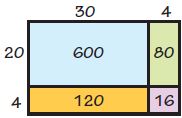
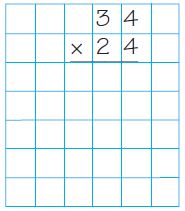
_____
Answer:
816
Explanation:


Question 2.
1 2
× 1 2
——–
_____
Answer:
144
Explanation:
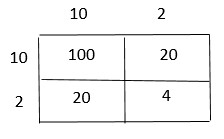

Question 3.
3 1
× 2 4
——-
_____
Answer:
744
Explanation:

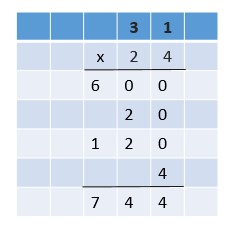
Question 4.
2 5
× 4 3
——-
_____
Answer:
1,075
Explanation:
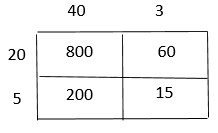

Question 5.
3 7
× 2 4
——-
_____
Answer:
888
Explanation:
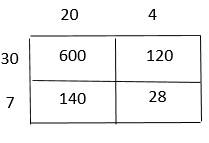
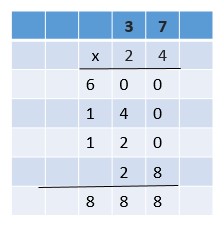
Question 6.
5 4
× 1 5
——-
_____
Answer:
810
Explanation:
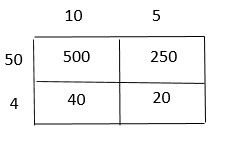

Question 7.
8 7
× 1 6
——-
_____
Answer:
1,392
Explanation:
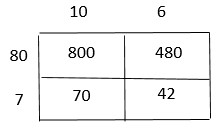

Question 8.
6 2
× 5 6
——-
_____
Answer:
3,472
Explanation:
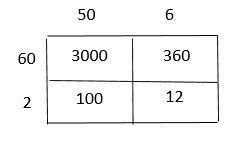
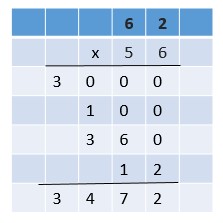
Question 9.
4 9
× 6 3
——-
_____
Answer:
3,087
Explanation:
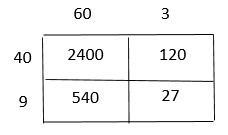

Practice: Copy and Solve Record the product.
Question 10.
38 × 47
_____
Answer:
1,786
Explanation:
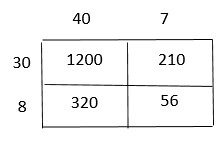

Question 11.
46 × 27
_____
Answer:
1,242
Explanation:

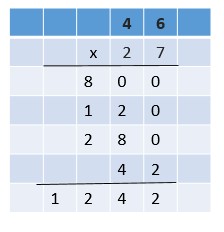
Question 12.
72 × 53
_____
Answer:
3,816
Explanation:
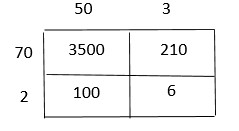
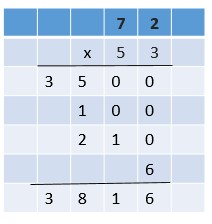
Question 13.
98 × 69
_____
Answer:
6,762
Explanation:
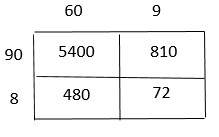
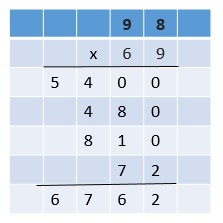
Question 14.
53 × 68
_____
Answer:
3,604
Explanation:

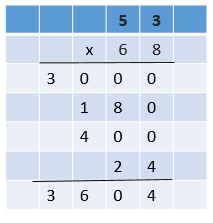
Question 15.
76 × 84
_____
Answer:
6,384
Explanation:


Question 16.
92 × 48
_____
Answer:
4,416
Explanation:
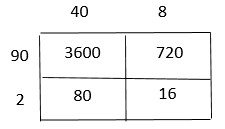
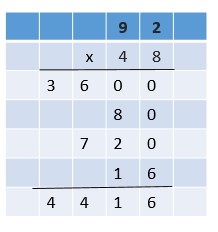
Question 17.
37 × 79
_____
Answer:
2,923
Explanation:
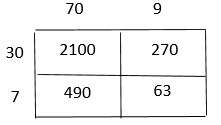
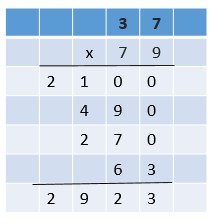
Reason Abstractly Algebra Find the unknown digits. Complete the problem.
Question 18.
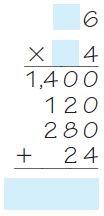
Type below:
___________
Answer:
1,824
Explanation:
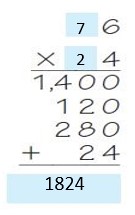
Question 19.

Type below:
___________
Answer:
7,954
Explanation:
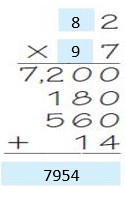
Question 20.

Type below:
___________
Answer:
1,908
Explanation:

Question 21.

Type below:
___________
Answer:
952
Explanation:

Page No. 166
Use the picture graph for 22–24.

Question 22.
Use Graphs A fruit-packing warehouse is shipping 15 boxes of grapefruit to a store in Santa Rosa, California. What is the total weight of the shipment?
______ pounds
Answer:
1275 pounds
Explanation:
From the given data,
A fruit packing warehouse is shipping 15 boxes of grapefruit to store in Santa Rose, California
Grapefruit weight per box = 85 pounds
Total weight of the shipment = 85 x 15
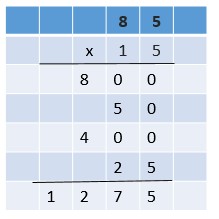
So, the total weight of the shipment = 1275 pounds
Question 23.
How much less do 13 boxes of tangelos weigh than 18 boxes of tangerines?
______ pounds
Answer:
450 pounds
Explanation:
As per the given data,
Tangelos weight per box = 90 pounds
Then, the weight of the 13 boxes of tangelos = 90 x 13
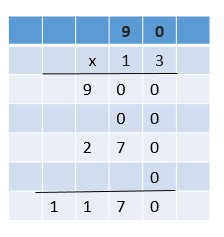
And, the weight of the 18 boxes of tangelos = 90 x 18

1620 – 1170 = 450
So, 13 boxes of tangelos weight are 450 pounds less than 18 boxes of tangelos weight
Question 24.
What is the weight of 12 boxes of oranges?
______ pounds
Answer:
1,080 pounds
Explanation:
The weight of the oranges per box = 90 pounds
then, weight of 12 boxes oranges = 90 x 12

So, weight of 12 boxes oranges = 1,080 pounds
Question 25.
Each person in the United States eats about 65 fresh apples each year. Based on this estimate, how many apples do 3 families of 4 eat each year?
______ apples
Answer:
780 apples
Explanation:
From the given data,
Each person in the united states eats fresh apples per year = 65
3 families of 4 persons = 3 x 4 = 12 persons
Then, the number of apples eat by 12 persons = 65 x 12
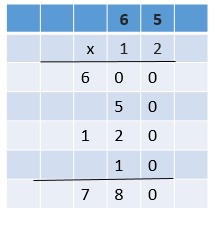
So, the total number of apples eat by 12 persons per year = 780
Question 26.
The product 26 × 93 is greater than 25 × 93. How much greater? Explain how you know without multiplying.
______
Answer:
The difference is 93
26 x 93 is one more group of 93 than 25 x 93
Question 27.
Margot wants to use partial products to find 22 × 17. Write the numbers in the boxes to show 22 × 17.
![]()
Type below:
__________
Answer:
![]()
Explanation:
22 x 17
(20 + 2) x 17
20 x 17 + 2 x 17
20 x (10 + 7) + 2 x (10 + 7)
(20 x 10) + (20 x 7) + (2 x 10) + (2 x 7)
![]()
Common Core – Page No. 167
Multiply Using Partial Products
Record the product.
Question 1.
2 3
× 7 9
———
1, 4 0 0
2 1 0
1 8 0
+ 2 7
——–
1, 8 1 7
Answer:
1, 8 1 7
Explanation:
2 3
× 7 9
———
1, 4 0 0
2 1 0
1 8 0
+ 2 7
——–
1, 8 1 7
Question 2.
5 6
× 3 2
——-
_______
Answer:
1,792
Explanation:
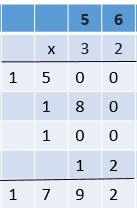
Question 3.
8 7
× 6 4
——-
_______
Answer:
5,568
Explanation:

Question 4.
3 3
× 2 5
——-
_______
Answer:
825
Explanation:

Question 5.
9 4
× 1 2
——-
_______
Answer:
1,128
Explanation:
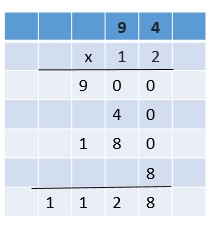
Question 6.
5 1
× 7 7
——-
_______
Answer:
3,927
Explanation:
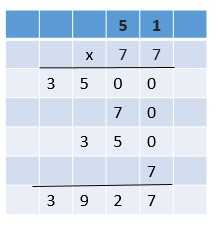
Question 7.
6 9
× 4 9
——-
_______
Answer:
3,381
Explanation:

Question 8.
8 6
× 8 4
——-
_______
Answer:
7,224
Explanation:
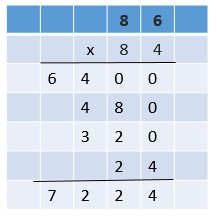
Question 9.
9 8
× 4 2
——-
_______
Answer:
4,116
Explanation:

Question 10.
7 3
× 3 7
——-
_______
Answer:
2,701
Explanation:
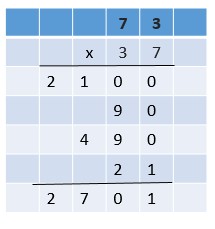
Question 11.
8 5
× 5 1
——-
_______
Answer:
4,335
Explanation:

Problem Solving
Question 12.
Evelyn drinks 8 glasses of water a day, which is 56 glasses of water a week. How many glasses of water does she drink in a year? (1 year = 52 weeks)
_______ glasses
Answer:
2,912 glasses
Explanation:
As per the given data,
Evelyn drinks 8 glasses of water a day
Evelyn drinks water per week = 56 glasses
Then, the number of glasses per 52 weeks = 52 x 56
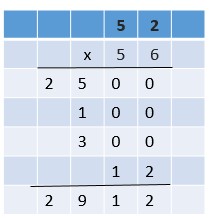
Total number of glasses of water drink by Evelyn per year = 2912 glasses of water
Question 13.
Joe wants to use the Hiking Club’s funds to purchase new walking sticks for each of its 19 members. The sticks cost $26 each. The club has $480. Is this enough money to buy each member a new walking stick? If not, how much more money is needed?
Is the money enough? _______
How much more is needed? _______
Answer:
This amount is not enough to buy walking sticks
Still, $14 amount is needed to buy walking sticks
Explanation:
From the given data,
Joe wants to use the Hiking club funds to purchase new walking sticks for each of its 19 members
Cost per each stick = $26
Total walking sticks cost per 19 members = $26 x 19

Total cost for walking sticks for 19 members = $494
The club has = $480
This amount is not enough to buy walking sticks
Still, $14 amount is needed to buy walking sticks
Common Core – Page No. 168
Lesson Check
Question 1.
A carnival snack booth made $76 selling popcorn in one day. It made 22 times as much selling cotton candy. How much money did the snack booth make selling
cotton candy?
Options:
a. $284
b. $304
c. $1,562
d. $1,672
Answer:
d. $1,672
Explanation:
As per the given data,
A carnival snack booth made popcorn in one day = $76
It made 22 times as much selling cotton candy
Then, total selling cotton candy made by snack booth = $76 x 22

So, $1672 money snack booth will get for selling cotton candy
Question 2.
What are the partial products of
42 × 28?
Options:
a. 800, 80, 40, 16
b. 800, 16
c. 800, 40, 320, 16
d. 80, 16
Answer:
c. 800, 40, 320, 16
Explanation:
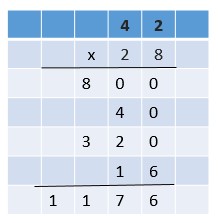
So, partial products of 42 x 28 are 800, 40, 320, 16
Spiral Review
Question 3.
Last year, the city library collected 117 used books for its shelves. This year, it collected 3 times as many books. How many books did it collect this year?
Options:
a. 832
b. 428
c. 351
d. 72
Answer:
c. 351
Explanation:
From the given data,
Last year, the number of used books collected by city library by its shelves = 117 books
This year, it collected 3 times as many books = 3 x 117 =351 books
Total number of books collected by the city library for this year = 351 books
Question 4.
Washington Elementary has 232 students. Washington High has 6 times as many students. How many students does Washington High have?
Options:
a. 1,392
b. 1,382
c. 1,292
d. 1,281
Answer:
a. 1,392
Explanation:
As per the given data,
The number of students in Washington elementary = 232 students
Washington High has 6 times as many students = 6 x 232 = 1392
Total number of students in Washington High = 1392 students
Question 5.
What are the partial products of 35 × 7?
Options:
a. 10, 12
b. 21, 35
c. 210, 35
d. 350, 21
Answer:
c. 210, 35
Explanation:
Partial products of 35 x 7 are 210, 35
Question 6.
Shelby has ten $5 bills and thirteen $10 bills. How much money does Shelby have in all?
Options:
a. $15
b. $60
c. $63
d. $180
Answer:
d. $180
Explanation:
From the given data,
Shelby has ten $5 bills and thirteen $10 bills = (10 x $5) + (13 x $10)
= ($50) + ($130)
=$180
Total money with Shelby = $180
Page No. 169
Question 1.
Explain how to find 40 × 50 using mental math.
Type below:
__________
Answer:
200
Explanation:
40 x 50
By using mental math
4 x 5 = 20
40 x 50 = 200
Question 2.
What is the first step in estimating 56 × 27?
Type below:
__________
Answer:
18 centimeters
Explanation:
Round to the nearest values.
So, the first step of the estimated 56 x 27 is rounding to the nearest values that is 60 x 30
Choose a method. Then find the product.
Question 3.
35 × 10 = _____
Answer:
350
Explanation:
By using the place value method
You can take 10 as 1 ten
35 x 10 = 35 x 1 ten
= 35 ten
35 x 10 = 350
Question 4.
19 × 20 = _____
Answer:
380
Explanation:
19 x 20
By using the associative property
You can think of 20 as (2 x 10)
19 x 20 = 19 x (2 x 10)
= (19 x 2) x 10
= 38 x 10
19 x 20 = 380
Question 5.
12 × 80 = _____
Answer:
960
Explanation:
Use the halving and doubling strategy
half of the 80 to make the problem simpler
80/ 2 = 40
Multiply 40 with 12
40*12 = 480
Double the 480
2*480= 960
12*80 = 960
Question 6.
70 × 50 = _____
Answer:
3,500
Explanation:
70 x 50
By using the place value method
You can take 50 as 5 tens
70 x 50 = 70 x 5 tens
= 350 tens
70 x 50 = 3,500
Question 7.
58 × 40 = _____
Answer:
2,320
Explanation:
By using the associative property
You can think of 40 as (4 x 10)
58 x 40 = 58 x (4 x 10)
= (58 x 4) x 10
= 232 x 10
58 x 40 = 2,320
Question 8.
30 × 40 = _____
Answer:
1,200
Explanation:
Use the halving and doubling strategy
half of the 40 to make the problem simpler
40/ 2 = 20
Multiply 20 with 30
20*30 = 600
Double the 600
2*600= 1200
30*40 = 1,200
Question 9.
14 × 60 = _____
Answer:
840
Explanation:
By using the place value method
You can take 60 as 6 tens
14 x 60 = 14 x 6 tens
= 84 tens
14 x 60 = 840
Question 10.
20 × 30 = _____
Answer:
600
Explanation:
By using the associative property
You can think of 30 as (3 x 10)
20 x 30 = 20 x (3 x 10)
= (20 x 3) x 10
= 60 x 10
20 x 30 = 600
Question 11.
16 × 90 = _____
Answer:
1,440
Explanation:
Use the halving and doubling strategy
half of the 90 to make the problem simpler
90/ 2 = 45
Multiply 45 with 16
16*45 = 720
Double the 720
2*720= 1440
16*90 = 1,440
Estimate the product. Choose a method.
Question 12.
81 × 38
Estimate: _____
Answer:
3,200
Explanation:
Round to the nearest tens.
81 is close to 80; 38 is close to 40;
80 x 40 = 3,200
Question 13.
16 × $59
Estimate: $ _____
Answer:
$120
Explanation:
Round to the nearest tens.
16 is close to 20; $59 is close to $60;
Use the mental math to find the product of 20 x $60
2 x $6 = $12
20 x $60 = $120
Estimated product of 16 x $59 = $120
Question 14.
43 × 25
Estimate: _____
Answer:
1,000
Explanation:
Round to the nearest tens.
43 is close to 40; 25 is close to 25;
40 x 25 = 1000
Estimated product of 43 x 25 = 1,000
Question 15.
76 × 45
Estimate: _____
Answer:
3,200
Explanation:
Round to the nearest tens.
76 is close to 80; 45 is close to 40;
Use the mental math
8 x 4 = 32
80 x 40 = 3200
So, the estimated product of 76 x 45 = 3,200
Question 16.
65 × $79
Estimate: _____
Answer:
$4,800
Explanation:
Round to the nearest tens.
65 is close to 60; $79 is close to $80;
Use the mental math
6 x $8 = $48
60 x $80 = $4800
So, estimated product of 65 x $79 = $4,800
Question 17.
92 × 38
Estimate: _____
Answer:
3,600
Explanation:
Round to the nearest tens.
92 is close to 90; 38 is close to 40;
Use the mental math, then
9 x 4 = 36
90 x 40 = 3,600
So, estimated product of 92 x 38 = 3,600
Question 18.
37 × 31
Estimate: _____
Answer:
1,200
Explanation:
Round to the nearest tens.
37 is close to 40; 31 is close to 30;
Use the mental math, then
4 x 3 = 12
40 x 30 = 1,200
So, estimated product of 37 x 31 = 1,200
Question 19.
26 × $59
Estimate: _____
Answer:
$1,800
Explanation:
Round to the nearest tens.
26 is close to 30; $59 is close to $60;
Use the mental math, then
3 x $6 = $18
30 x $60 = $1,800
So, estimated product of 26 x $59 = $1,800
Question 20.
54 × 26
Estimate: _____
Answer:
18 centimeters
Explanation:
Round to the nearest tens.
54 is close to 50; 26 is close to 30;
Use the mental math
5 x 3 = 15
50 x 30 = 1,500
So, estimated product of 54 x 26 = 1,500
Question 21.
52 × 87
Estimate: _____
Answer:
4,500
Explanation:
Round to the nearest tens.
52 is close to 50; 87 is close to 90;
Use the mental math
5 x 9 = 45
50 x 90 = 4500
So, estimated product of 52 x 87 = 4,500
Question 22.
39 × 27
Estimate: _____
Answer:
18 centimeters
Explanation:
Round to the nearest tens.
39 is close to 40; 27 is close to 30;
Use the mental math
4 x 3 = 12
40 x 30 = 1,200
So, estimated product of 39 x 27 = 1,200
Question 23.
63 × 58
Estimate: _____
Answer:
3,600
Explanation:
Round to the nearest tens.
63 is close to 60; 58 is close to 60;
Use the mental math
6 x 6 = 36
60 x 60 = 3,600
So, estimated product of 63 x 58 = 3,600
Page No. 170
Question 24.
Ms. Traynor’s class is taking a field trip to the zoo. The trip will cost $26 for each student. There are 22 students in her class. What is a good estimate for the cost of the students’ field trip?
Type below:
__________
Answer:
18 centimeters
Explanation:
As per the given data,
Ms. Traynor’s class is taking a field trip to the zoo
Cost of the trip for each student = $26
Total number of students in her class = 22
The total cost of the trip for students = $26 x 22
Round to the nearest tens.
26 is close to 30; 22 is close to 20;
Use the mental math
$3 x 2 = $6
$30 x 20 = $600
Then, the total estimated cost for the trip for students = $600
Question 25.
Tito wrote the following on the board. What is the unknown number?
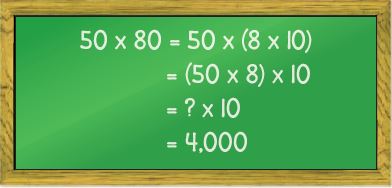
______
Answer:
400
Explanation:
An unknown number is 50 x 8 = 400
Question 26.
What are the partial products that result from multiplying 15 × 32?
Type below:
__________
Answer:
Partial products are 300, 150, 20, 10
Explanation:

Partial products are 300, 150, 20, 10
Question 27.
A city bus company sold 39 one-way tickets and 20 round-trip tickets from West Elmwood to East Elmwood. One-way tickets cost $14. Round trip tickets cost $25. How much money did the bus company collect?
$ ______
Answer:
$1,046
Explanation:
As per the given data,
Number of one – way tickets sold by the city bus company = 39
Round trip tickets from west Elmwood to east Elmwood = 20
Cost of one – way tickets = $14
Then, cost of 39 one – way tickets = 39 x $14 =$546
Cost of round trip tickets = $25
Then, cost of 20 round trip tickets = $25 x 20 = $500
Total money collected by the city bus company = $546 + $500 = $1,046
Page No. 173
Question 1.
Look at the problem. Complete the sentences.
Multiply ____ and ____ to get 0.
Multiply ____ and ____ to get 1,620.
Add the partial products.
0 + 1,620 = ____

_____
Answer:
Multiply 27 and 0 to get 0.
Multiply 27 and 6 to get 1,620.
Add the partial products. 0 + 1,620 = 1,620.
Estimate. Then find the product.
Question 2.
6 8
× 5 3
——-
Estimate: _________
Product: __________
Answer:
Estimate: 3,500
Product: 3,604
Explanation:
68 is closer to 70 and 53 is closer to 50
Estimate: 70 x 50 = 3,500
60 x 53 = 3180
8 x 53 = 424
3180 + 424 = 3604
Product 3,604
Question 3.
6 1
× 5 4
——-
Estimate: _________
Product: __________
Answer:
Estimate: 3,000
Product: 3,294
Explanation:
61 is closer to 60 and 54 is closer to 50
Estimate: 60 x 50 = 3,000
60 x 54 = 3240
1 x 54 = 54
3240 + 54 = 3294
Product 3,294
Question 4.
9 0
× 2 7
——-
Estimate: _________
Product: __________
Answer:
Estimate: 2,700
Product: 2,430
Explanation:
27 is closer to 30
Estimate: 90 x 30 = 2,700
90 x 27 = 2430
Product 2,430
Question 5.
3 0
× 4 7
——-
Estimate: _________
Product: __________
Answer:
Estimate: 1,500
Product: 1,410
Explanation:
47 is closer to 50
Estimate: 30 x 50 = 1,500
30 x 47 = 1410
Product 1,410
Question 6.
7 8
× 5 6
——-
Estimate: _________
Product: __________
Answer:
Estimate: 4,800
Product: 4,368
Explanation:
78 is closer to 80 and 56 is closer to 60
Estimate: 80 x 60 = 4,800
70 x 56 = 3920
8 x 56 = 448
3920 + 448 = 4368
Product 4,368
Question 7.
2 7
× 2 5
——-
Estimate: _________
Product: __________
Answer:
Estimate: 600
Product: 675
Explanation:
27 is closer to 30 and 25 is closer to 20
Estimate: 30 x 20 = 600
20 x 25 = 500
7 x 25 = 175
500 + 175 = 675
Product 675
Practice: Copy and Solve Estimate. Then find the product.
Question 8.
34 × 65
Estimate: _________
Product: __________
Answer:
Estimate: 1,800
Product: 2,210
Explanation:
34 is closer to 30 and 65 is closer to 60
Estimate: 30 x 60 = 1,800
30 x 65 = 1950
4 x 65 = 260
1950 + 260 = 2210
Product 2,210
Question 9.
42 × $13
Estimate: $ _________
Product: $ _________
Answer:
Estimate: $400
Product: $546
Explanation:
42 is closer to 40 and 13 is closer to 10
Estimate: 40 x 10 = 400
40 x $13 = $520
2 x $13= $26
$520 + $26 = $546
Product $546
Question 10.
60 × 17
Estimate: _________
Product: __________
Answer:
Estimate: 1,200
Product: 1,020
Explanation:
17 is closer to 20
Estimate: 60 x 20 = 1,200
60 x 17 = 1020
Product = 1,020
Question 11.
62 × 45
Estimate: _________
Product: __________
Answer:
Estimate: 2,400
Product: 2,790
Explanation:
62 is closer to 60 and 45 is closer to 40
Estimate: 60 x 40 = 2,400
60 x 45 = 2700
2 x 45= 90
2700 + 90 = 2790
Product 2,790
Question 12.
57 × $98
Estimate: $ _________
Product: $ _________
Answer:
Estimate: 6,000
Product: 5,586
Explanation:
57 is closer to 60 and 98 is closer to 100
Estimate: 60 x 100 = 6,000
50 x 98 = 4900
7 x 98= 686
4900 + 686 = 5586
Product 5,586
Look for a Pattern Algebra Write a rule for the pattern.
Use your rule to find the unknown numbers.
Question 13.

Rule _____________
Type below:
_________
Answer:

Explanation:
1 hour = 60 min
Then, 5hr = 5 x 60 = 300 min
10hr = 10 x 60 = 600 min
15hr = 15 x 60 = 900 min
20hr = 20 x 60 = 1200 min
25hr = 25 x 60 = 1500 min
Question 14.
Owners of a summer camp are buying new cots for their cabins. There are 16 cabins. Each cabin needs 6 cots. Each cot costs $92. How much will the new cots cost?
$ _______
Answer:
$8,832
Explanation:
As per the given data,
Owners pf a summer camp are buying new cots for their cabins
Number of cabins = 16
Each cabin needs 6 cots
Then, total cots = 16 x 6 = 96
Each cot cost = $92
Then, cost for total cots = $92 x 96
92 is closer to 90 and 96 is closer to 100
Estimate = 90 x 100 = 9,000
90 x 96 = 8640
2 x 96 = 192
8640 + 192 = 8832
Product = 8,832
Question 15.
A theater has 28 rows of 38 seats downstairs and 14 rows of 26 seats upstairs. How many seats does the theater have?
______ seats
Answer:
1,428 seats
Explanation:
As per the given data,
A theatre has 28 rows of 38 seats downstairs = 28 x 38 = 1064
14 rows of 26 seats upstairs = 14 x 26 = 364
Total number of seats = 1064 + 364 = 1,428 seats
Page No. 174
Question 16.
Machine A can label 11 bottles in 1 minute. Machine B can label 12 bottles in 1 minute. How many bottles can both machines label in 15 minutes?

a. What do you need to know?
Type below:
__________
Answer:
number of bottles labeled by Machine A and Machine B in 15 minutes
Question 16.
b. What numbers will you use?
Type below:
__________
Answer:
15x 11 and 15 x 12
Question 16.
c. Tell why you might use more than one operation to solve the problem.
Type below:
__________
Answer:
To find out the total number of bottle made by both machines A & B
Question 16.
d. Solve the problem.
So, both machines can label ____ bottles in ____ minutes.
Type below:
__________
Answer:
Machine A can label 11 bottles in 1 minute
Then, the number of bottles labeled by machine A in 15 minutes = 15 x 11 = 165
Machine B can label 12 bottles in 1 minute
Then, number of bottles labelled by Machine B in 15 minutes = 15 x 12 = 180
Total bottles labelled by both the machines in 15 minutes = 165 + 180 = 345
Question 17.
Make Sense of Problems
A toy company makes wooden blocks. A carton holds 85 blocks. How many blocks can 19 cartons hold?
______ blocks
Answer:
1,615 blocks
Explanation:
From the given data,
A toy company makes wooden blocks
A carton holds 85 blocks
Then, number of blocks hold by 19 cartons = 19 x 85 = 1615
Total number of blocks held by 19 cartons = 1,615
Question 18.
A company is packing cartons of candles. Each carton can hold 75 candles. So far, 50 cartons have been packed, but only 30 cartons have been loaded on a truck. How many more candles are left to load on the truck?
______ candles
Answer:
1,500 candles
Explanation:
As per the given data,
A company is packing cartons of candles
Each carton can hold 75 candles
Then, number of candles hold by 50 cartons = 50 x 75 = 3750
Number of candles hold by 30 cartons = 30 x 75 = 2250
50 cartons have been packed, but only 30 cartons have been loaded on a truck
Remaining candles are left to load on truck = 3750 – 2250 = 1,500
Question 19.
Mr. Garcia’s class raised money for a field trip to the zoo. There are 23 students in his class. The cost of the trip will be $17 for each student. What is the cost for all the students? Explain how you found your answer.
$ ______
Answer:
$391
Explanation:
As per the given data,
Mr. Garcia’s class raised money for a field trip to the zoo
Total number of students in his class = 23 students
Cost of the trip for each student = $17
Then, total cost for all the students = $17 x 23 = $391
Common Core – Page No. 175
Multiply with Regrouping
Estimate. Then find the product.
Question 1.
Estimate: 2,700
Think: 87 is close to 90 and 32 is close to 30.
90 × 30 = 2,700

Answer:
2,784
Explanation:
Think: 87 is close to 90 and 32 is close to 30.
90 × 30 = 2,700

Question 2.
7 3
× 2 8
——–
Estimate: ______
Product: _______
Answer:
Estimate: 2,100
Product: 2,044
Explanation:
Estimate: 73 is close to 70; 28 is close to 30.
So, 70 x 30 = 2,100.
Product: Write 73 as 7 tens and 3 ones. Multiply 28 by 3 ones.
2
28
x 73
——–
84 <– 3 x 28
Multiply 28 by 7 tens
5
28
x 73
——–
1960 <– 70 x 28
Add the partial products.
84 + 1960 = 2,044.
So, 73 x 28 = 2,044.
Question 3.
4 8
× 3 8
——–
Estimate: ______
Product: _______
Answer:
Estimate: 2,000
Product: 1,824
Explanation:
48 is close to 50 and 38 is close to 40.
Estimate: 50 × 40 = 2,000
40 x 38 = 1520
8 x 38 = 304
1520 + 304 = 1824.
Product: 1,824
Question 4.
5 9
× 5 2
——–
Estimate: ______
Product: _______
Answer:
Estimate: 3,000
Product: 3,068
Explanation:
59 is close to 60 and 52 is close to 50.
Estimate: 60 × 50 = 3,000
50 x 52 = 2600
9 x 52 = 468
2600 + 468 = 3068.
Product: 3,068.
Question 5.
8 4
× 4 0
——–
Estimate: ______
Product: _______
Answer:
Estimate: 3,200
Product: 3,360
Explanation:
84 is close to 80 and 40 is close to 40.
Estimate: 80 × 40 = 3,200
80 x 40 = 3,200
4 x 40 = 160
3200 + 160 = 3,360.
Product: 3,360.
Question 6.
8 3
× 7 7
——–
Estimate: ______
Product: _______
Answer:
Estimate: 6,400
Product: 6,391
Explanation:
83 is close to 80 and 77 is close to 80.
Estimate: 80 × 80 = 6,400
80 x 77 = 6,160
3 x 77 = 231
6,160 + 231 = 6,391.
Product: 6,391.
Question 7.
9 1
× 1 9
——–
Estimate: ______
Product: _______
Answer:
Estimate: 1,800
Product: 1,729
Explanation:
91 is close to 90 and 19 is close to 20.
Estimate: 90 × 20 = 1,800
90 x 19 = 1,710
1 x 19 = 19
1,710+ 19 = 1,729.
Product: 1,729.
Problem Solving
Question 8.
Baseballs come in cartons of 84 baseballs. A team orders 18 cartons of baseballs. How many baseballs does the team order?
_______ baseballs
Answer:
1,512 baseballs
Explanation:
To find total baseballs, 84 x 18
80 x 18 = 1,440
4 x 18 = 72
84 x 18 = 1,512
Question 9.
There are 16 tables in the school lunch room. Each table can seat 22 students. How many students can be seated at lunch at one time?
_______ students
Answer:
352 students
Explanation:
Total Students = 16 x 22
10 x 22 = 220
6 x 22 = 132
220 + 132 = 352.
352 students can be seated at lunch at one time
Common Core – Page No. 176
Lesson Check
Question 1.
The art teacher has 48 boxes of crayons. There are 64 crayons in each box. Which is the best estimate of the number of crayons the art teacher has?
Options:
a. 2,400
b. 2,800
c. 3,000
d. 3,500
Answer:
c. 3,000
Explanation:
1. Total number of crayons = 48 x 64
48 is close to 50; 64 is close to 60
50 x 60 = 3,000.
The art teacher has about to 3, 000 crayons.
Question 2.
A basketball team scored an average of 52 points in each of 15 games. How many points did the team score in all?
Options:
a. 500
b. 312
c. 780
d. 1,000
Answer:
c. 780
Explanation:
Total Points = 52 x 15
50 x 15 = 750
2 x 15 = 30
750 + 30 = 780.
The basketball team scored 780 points in total.
Spiral Review
Question 3.
One Saturday, an orchard sold 83 bags of apples. There are 27 apples in each bag. Which expression represents the total number of apples sold?
Options:
a. 16 + 6 + 56 + 21
b. 160 + 60 + 56 + 21
c. 160 + 60 + 560 + 21
d. 1,600 + 60 + 560 + 21
Answer:
d. 1,600 + 60 + 560 + 21
Explanation:
Total number of apples sold = 83 x 27
80 x 27 = 2,160
3 x 27 = 81
2,160 + 81 = 2,241.
The total number of apples sold = 2,241.
16 + 6 + 56 + 21 = 99 not equal to 2,241
160 + 60 + 56 + 21 = 297 not equal to 2,241
160 + 60 + 560 + 21 = 801 not equal to 2,241
1,600 + 60 + 560 + 21 = 2,241 equal to 2,241
1,600 + 60 + 560 + 21 = 2,241 is correct.
Question 4.
Hannah has a grid of squares that has 12 rows with 15 squares in each row. She colors 5 rows of 8 squares in the middle of the grid blue. She colors the rest of
the squares red. How many squares does Hannah color red?
Options:
a. 40
b. 140
c. 180
d. 220
Answer:
b. 140
Explanation:
Hannah has a grid of squares that has 12 rows with 15 squares in each row = 12 x 15 = 180.
The grid of squares in blue = 5 x 8 = 40.
The grid of squares in red = 180 – 40 = 140.
Question 5.
Gabriella has 4 times as many erasers a Leona. Leona has 8 erasers. How many erasers does Gabriella have?
Options:
a. 32
b. 24
c. 12
d. 2
Answer:
a. 32
Explanation:
Gabriella have 4 x 8 = 32 erasers.
Question 6.
Phil has 3 times as many rocks as Peter. Together, they have 48 rocks. How many more rocks does Phil have than Peter?
Options:
a. 36
b. 24
c. 16
d. 12
Answer:
b. 24
Explanation:
Phil has 3 times as many rocks as Peter. Together, they have 48 rocks
If Peter has x rocks, Phil has 3x rocks
3x + x = 48.
4x = 48.
x = 48/4 = 12.
Peter has 12 rocks. Phil has 3 x 12 = 36 rocks.
Phil has 36 – 12 = 24 more rocks than Peter.
Page No. 179
Question 1.
Find the product.
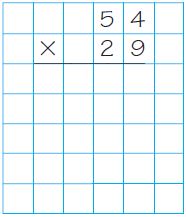
Estimate: ______
Product: _______
Answer:
Estimate: 1,500
Product: 1,566
Explanation:
54 x 29
Estimate: Think 54 is close to 50; 29 is close to 30.
50 x 30 = 1,500
Product:
20 x 5 tens = 100 tens
20 x 4 ones = 80 ones
9 x 5 tens = 45 tens
9 x 4 ones = 36 ones.
Add partial products.
1000 + 80 + 450 + 36 = 1,566.
Estimate. Then choose a method to find the product.
Question 2.
3 6
× 1 4
——-
Estimate: ______
Product: _______
Answer:
Estimate: 400
Product: 504
Explanation:
36 x 14
Estimate: Think 36 is close to 40; 14 is close to 10.
40 x 10 = 400
Product:
10 x 3 tens = 30 tens
10 x 6 ones = 60 ones
4 x 3 tens = 12 tens
4 x 6 ones = 24 ones.
Add partial products.
300 + 60 + 120 + 24 = 504.
Question 3.
6 3
× 4 2
——-
Estimate: ______
Product: _______
Answer:
Estimate: 2,400
Product: 2646
Explanation:
63 x 42
Estimate: Think 63 is close to 60; 42 is close to 40.
60 x 40 = 2400
Product:
40 x 6 tens = 240 tens
40 x 3 ones = 120 ones
2 x 6 tens = 12 tens
2 x 3 ones = 6 ones.
Add partial products.
2400 + 120 + 120 + 6 = 2646.
Question 4.
8 4
× 5 3
——-
Estimate: ______
Product: _______
Answer:
Estimate: 4,000
Product: 4,452
Explanation:
84 x 53
Estimate: Think 84 is close to 80; 53 is close to 50.
80 x 50 = 4,000
Product:
50 x 8 tens = 400 tens
50 x 4 ones = 200 ones
3 x 8 tens = 24 tens
3 x 4 ones = 12 ones.
Add partial products.
4000 + 200 + 240 + 12 = 4,452.
Question 5.
7 1
× 1 3
——-
Estimate: ______
Product: _______
Answer:
Estimate: 700
Product: 923
Explanation:
71 x 13
Estimate: Think 71 is close to 70; 13 is close to 10.
70 x 10 = 700
Product:
10 x 7 tens = 70 tens
10 x 1 ones = 10 ones
3 x 7 tens = 21 tens
3 x 1 ones = 3 ones.
Add partial products.
700 + 10 + 210 + 3 = 923.
Practice: Copy and Solve Estimate. Find the product.
Question 6.
29 × $82
Estimate: $ _______
Product: $ _______
Answer:
Estimate: $2,400
Product: $2,378
Explanation:
29 x $82
Estimate: Think 29 is close to 30; $82 is close to $80.
30 x $80 = $2,400
Product:
$80 x 2 tens = $160 tens
$80 x 9 ones = $720 ones
$2 x 2 tens = $4 tens
$2 x 9 ones = $18 ones.
Add partial products.
$1600 + $720 + $40 + $18 = $2,378.
Question 7.
57 × 79
Estimate: _______
Product: _______
Answer:
Estimate: 4,800
Product: 4,503
Explanation:
57 x 79
Estimate: Think 57 is close to 60; 79 is close to 80.
60 x 80 = 4,800
Product:
70 x 5 tens = 350 tens
70 x 7 ones = 490 ones
9 x 5 tens = 45 tens
9 x 7 ones = 63 ones.
Add partial products.
3500 + 490 + 450 + 63 = 4,503.
Question 8.
80 × 27
Estimate: _______
Product: _______
Answer:
Estimate: 2,400
Product: 2,160
Explanation:
80 x 27
Estimate: Think 27 is close to 30.
30 x 80 = 2,400
Product:
20 x 8 tens = 160 tens
20 x 0 ones = 0 ones
7 x 8 tens = 56 tens
7 x 0 ones = 0 ones.
Add partial products.
1600 + 0 + 560 + 0 = 2,160.
Question 9.
32 × $75
Estimate: $ _______
Product: $ _______
Answer:
Estimate: $2,100
Product: $2,400
Explanation:
32 × $75
Estimate: Think 32 is close to 30; $75 is close to $70.
30 x $70 = $2,100
Product:
$70 x 3 tens = $210 tens
$70 x 2 ones = $140 ones
$5 x 3 tens = $15 tens
$5 x 2 ones = $10 ones.
Add partial products.
$2100 + $140 + $150 + $10 = $2,400.
Question 10.
55 × 48
Estimate: _______
Product: _______
Answer:
Estimate: 2,750
Product: 2,640
Explanation:
55 × 48
Estimate: Think 48 is close to 50.
55 x 50 = 2,750
Product:
40 x 5 tens = 200 tens
40 x 5 ones = 200 ones
8 x 5 tens = 40 tens
8 x 5 ones = 40 ones.
Add partial products.
2000 + 200 + 400 + 40 = 2,640.
Question 11.
19 × $82
Estimate: $ _______
Product: $ _______
Answer:
Estimate: $1,600
Product: $1,558
Explanation:
19 × $82
Estimate: Think 19 is close to 20; $82 is close to $80.
20 x $80 = $1,600
Product:
$80 x 1 tens = $80 tens
$80 x 9 ones = $720 ones
$2 x 1 tens = $2 tens
$2 x 9 ones = $18 ones.
Add partial products.
$800 + $720 + $20 + $18 = $1,558.
Question 12.
25 × $25
Estimate: $ _______
Product: $ _______
Answer:
Estimate: $625
Product: $625
Explanation:
25 × $25
Estimate:
25 x $25 = $625
Product:
$20 x 2 tens = $40 tens
$20 x 5 ones = $100 ones
$5 x 2 tens = $10 tens
$5 x 5 ones = $25 ones.
Add partial products.
$400 + $100 + $100 + $25 = $625.
Question 13.
41 × 98
Estimate: _______
Product: _______
Answer:
Estimate: 4,000
Product: 4,018
Explanation:
41 × 98
Estimate: Think 41 is close to 40; 98 is close to 100.
40 x 100 = 4,000
Product:
90 x 4 tens = 360 tens
90 x 1 ones = 90 ones
8 x 4 tens = 32 tens
8 x 1 ones = 8 ones.
Add partial products.
3600 + 90 + 320 + 8 = 4,018.
Identify Relationships Algebra Use mental math to find the number.
Question 14.
30 × 14 = 420, so
30 × 15 = ______
Answer:
30 × 15 = 450
Explanation:
30 × 15 = 30 + 420
30 × 15 = 450
Question 15.
25 × 12 = 300, so
25 × ______ = 350
Answer:
25 x 14 = 350
Explanation:
25 × 12 = 300
For every next multiplication, the product value is increased by 25.
25 x 13 = 325.
25 x 14 =350.
Question 16.
The town conservation manager bought 16 maple trees for $26 each. She paid with five $100 bills. How much change will the manager receive? Explain.
$ ______
Answer:
$84
Explanation:
The town conservation manager bought 16 maple trees for $26 each = 16 x $26 = $416.
She paid with five $100 bills = 5 x $100 = $500.
The manager receive = $500 – $416 = $84.
Question 17.
Each of 25 students in Group A read for 45 minutes. Each of 21 students in Group B read for 48 minutes. Which group read for more minutes? Explain.
_________
Answer:
Group A read for more minutes than Group B.
Explanation:
Group A read for 25 x 45 = 1125 minutes.
Group B read for 21 x 48 = 1008 minutes.
Group A read for more minutes than Group B.
Page No. 180
Question 18.
Martin collects stamps. He counted 48 pages in his collector’s album. The first 20 pages each have 35 stamps in 5 rows. The rest of the pages each have 54 stamps. How many stamps does Martin have in his album?
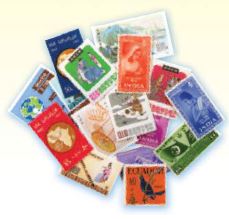
a. What do you need to know?
Type below:
_________
Answer:
The total stamps in the first 20 pages + The total stamps in the remaining pages.
Question 18.
b. How will you use multiplication to find the number of stamps?
Type below:
_________
Answer:
The first 20 pages each have 35 stamps in 5 rows.
So, 35 x 5 = 175 stamps.
Question 18.
c. Tell why you might use addition and subtraction to help solve the problem.
Type below:
_________
Answer:
As mentioned that the number of stamps available in the first 20 pages and the number of stamps available in the rest of the pages. We need to add all pages to get 48 pages stamps.
Question 18.
d. Show the steps to solve the problem.
Type below:
_________
Answer:
Martin has 48 pages in his collector’s album.
The first 20 pages each have 35 stamps in 5 rows.
So, 35 x 5 = 175 stamps.
The first 20 pages have 175 stamps.
The rest of the pages each have 54 stamps.
So, total stamps = 175 + 54 = 229 stamps.
Question 18.
e. Complete the sentences.
Martin has a total of _____ stamps on the first 20 pages.
There are _____ more pages after the first 20 pages in Martin’s album.
There are _____ stamps on the rest of the pages.
There are _____ stamps in the album.
Type below:
_________
Answer:
Martin has a total of __175___ stamps on the first 20 pages.
There are __24___ more pages after the first 20 pages in Martin’s album.
There are __54___ stamps on the rest of the pages.
There are ___229__ stamps in the album.
Question 19.
Select the expressions that have the same product as 35 × 17. Mark all that apply.
Options:
a. (30 × 10) + (30 × 7) + (5 × 10) + (5 × 7)
b. (30 × 17) + (5 × 17)
c. (35 × 30) + (35 × 5) + (35 × 10) + (35 × 7)
d. (35 × 10) + (35 × 7)
e. (35 × 10) + (30 × 10) + (5 × 10) + (5 × 7)
f. (35 × 30) + (35 × 5)
Answer:
a. (30 × 10) + (30 × 7) + (5 × 10) + (5 × 7)
b. (30 × 17) + (5 × 17)
d. (35 × 10) + (35 × 7)
Explanation:
35 × 17
30 x 10 =300
30 x 7 = 210
5 x 10 = 50
5 x 7 = 35
300 + 210 + 50 + 35 = 595.
a. (30 × 10) + (30 × 7) + (5 × 10) + (5 × 7) = 300 + 210 + 50 + 35 = 595 equal to 595.
b. (30 × 17) + (5 × 17) = 510 + 85 = 595 equal to 595.
c. (35 × 30) + (35 × 5) + (35 × 10) + (35 × 7) = 1050 + 175 + 350 + 245 = 1820 not equal to 595.
d. (35 × 10) + (35 × 7) = 350 + 245 = 595 equal to 595
e. (35 × 10) + (30 × 10) + (5 × 10) + (5 × 7) = 350 + 300 + 50 + 35 = 735 not equal to 595.
f. (35 × 30) + (35 × 5) = 1050 + 175 = 1,225 not equal to 595.
Common Core – Page No. 181
Choose a Multiplication Method
Estimate. Then choose a method to find the product.
Question 1.
Estimate: 1,200
3 1
× 4 3
——-
9 3
+ 1, 2 4 0
————
1, 3 3 3
Answer:
Estimate: 1,200
Product: 1, 3 3 3
Explanation:
Estimate: 1,200
3 1
× 4 3
——-
9 3
+ 1, 2 4 0
————
1, 3 3 3
Question 2.
6 7
× 8 5
——-
Estimate: _____
Product: ______
Answer:
Estimate: 6,300
Product: 5,695
Explanation:
Estimate: 67 is close to 70; 85 is close to 90.
70 x 90 = 6,300.
Product: 67 x 85
80 x 6 tens = 480 tens
80 x 7 ones = 560 ones
5 x 6 tens = 30 tens
5 x 7 ones = 35 ones.
Add partial products.
4800 + 560 + 300 + 35 = 5,695.
Question 3.
6 8
× 3 8
——-
Estimate: _____
Product: ______
Answer:
Estimate: 2,800
Product: 2,584
Explanation:
Estimate: 68 is close to 70; 38 is close to 40.
70 x 40 = 2,800.
Product: 68 x 38
30 x 6 tens = 180 tens
30 x 8 ones = 240 ones
8 x 6 tens = 48 tens
8 x 8 ones = 64 ones.
Add partial products.
1800 + 240 + 480 + 64 = 2,584.
Question 4.
9 5
× 1 7
——-
Estimate: _____
Product: ______
Answer:
Estimate: 1,700
Product: 1,615
Explanation:
Estimate: 95 is close to 100.
100 x 17 = 1,700.
Product: 95 x 17
10 x 9 tens = 90 tens
10 x 5 ones = 50 ones
7 x 9 tens = 63 tens
7 x 5 ones = 35 ones.
Add partial products.
900 + 50 + 630 + 35 = 1,615.
Question 5.
4 9
× 5 4
——-
Estimate: _____
Product: ______
Answer:
Estimate: 2,500
Product: 2,646
Explanation:
Estimate: 49 is close to 50; 54 is close to 50.
50 x 50 = 2,500.
Product: 49 x 54
50 x 4 tens = 200 tens
50 x 9 ones = 450 ones
4 x 4 tens = 16 tens
4 x 9 ones = 36 ones.
Add partial products.
2000 + 450 + 160 + 36 = 2,646.
Question 6.
9 1
× 2 6
——-
Estimate: _____
Product: ______
Answer:
Estimate: 2,700
Product: 2,366
Explanation:
Estimate: 91 is close to 90; 26 is close to 30.
90 x 30 = 2,700.
Product: 49 x 54
20 x 9 tens = 180 tens
20 x 1 ones = 20 ones
6 x 9 tens = 54 tens
6 x 1 ones = 6 ones.
Add partial products.
1800 + 20 + 540 + 6 = 2,366.
Question 7.
8 2
× 1 9
——-
Estimate: _____
Product: ______
Answer:
Estimate: 1,600
Product: 1,558
Explanation:
Estimate: 82 is close to 80; 19 is close to 20.
80 x 20 = 1,600.
Product: 82 x 19
10 x 8 tens = 80 tens
10 x 2 ones = 20 ones
9 x 8 tens = 72 tens
9 x 2 ones = 18 ones.
Add partial products.
800 + 20 + 720 + 18 = 1,558.
Question 8.
4 6
× 2 7
——-
Estimate: _____
Product: ______
Answer:
Estimate: 1,500
Product: 1,242
Explanation:
Estimate: 46 is close to 50; 27 is close to 30.
50 x 30 = 1,500.
Product: 46 x 27
20 x 4 tens = 80 tens
20 x 6 ones = 120 ones
7 x 4 tens = 28 tens
7 x 6 ones = 42 ones.
Add partial products.
800 + 120 + 280 + 42 = 1,242.
Question 9.
4 1
× 3 3
——-
Estimate: _____
Product: ______
Answer:
Estimate: 1,200
Product: 1,353
Explanation:
Estimate: 41 is close to 40; 33 is close to 30.
40 x 30 = 1,200.
Product: 41 x 33
30 x 4 tens = 120 tens
30 x 1 ones = 30 ones
3 x 4 tens = 12 tens
3 x 1 ones = 3 ones.
Add partial products.
1200 + 30 + 120 + 3 = 1,353.
Question 10.
9 7
× 1 3
——-
Estimate: _____
Product: ______
Answer:
Estimate: 1,300
Product: 1,261
Explanation:
Estimate: 97 is close to 100.
100 x 13 = 1,300.
Product: 97 x 13
10 x 9 tens = 90 tens
10 x 7 ones = 70 ones
3 x 9 tens = 27 tens
3 x 7 ones = 21 ones.
Add partial products.
900 + 70 + 270 + 21 = 1,261.
Question 11.
7 5
× 6 9
——-
Estimate: _____
Product: ______
Answer:
Estimate: 5,600
Product: 5,195
Explanation:
Estimate: 75 is close to 80; 69 is close to 70.
80 x 70 = 5,600.
Product: 75 x 69
60 x 7 tens = 420 tens
60 x 5 ones = 300 ones
9 x 7 tens = 63 tens
9 x 5 ones = 45 ones.
Add partial products.
4200 + 300 + 630 + 45 = 5,195.
Problem Solving
Question 12.
A movie theatre has 26 rows of seats. There are 18 seats in each row. How many seats are there in all?
______ seats
Answer:
468 seats
Explanation:
26 x 18 = 468 seats.
20 x 18 = 360
6 x 18 = 108
108+360 = 468.
Question 13.
Each class at Briarwood Elementary collected at least 54 cans of food during the food drive. If there are 29 classes in the school, what was the least number of
cans collected?
______ cans
Answer:
1,566 cans
Explanation:
Each class at Briarwood Elementary collected at least 54 cans of food.
If there are 29 classes in the school,
the least number of cans collected = 54 x 29 = 1,566 cans.
Common Core – Page No. 182
Lesson Check
Question 1.
A choir needs new robes for each of its 46 singers. Each robe costs $32. What will be the total cost for all 46 robes?
Options:
a. $1,472
b. $1,372
c. $1,362
d. $230
Answer:
a. $1,472
Explanation:
46 x $32
40 x $32 = $1,280
6 x $32 = $192
$1,280 + $192 = $1,472
Question 2.
A wall on the side of a building is made up of 52 rows of bricks with 44 bricks in each row. How many bricks make up the wall?
Options:
a. 3,080
b. 2,288
c. 488
d. 416
Answer:
b. 2,288
Explanation:
52 x 44
50 x 44 = 2,200
2 x 44 = 88
2,200 + 88 = 2,288.
2,288 bricks make up the wall.
Spiral Review
Question 3.
Which expression shows how to multiply 4 × 362 by using place value and expanded form?
Options:
a. (4 × 3) + (4 × 6) + (4 × 2)
b. (4 × 300) + (4 × 600) +(4 × 200)
c. (4 × 300) + (4 × 60) + (4 × 20)
d. (4 × 300) + (4 × 60) + (4 × 2)
Answer:
d. (4 × 300) + (4 × 60) + (4 × 2)
Explanation:
4 × 362 = 1,448
a. (4 × 3) + (4 × 6) + (4 × 2) = 12 + 24 + 8 = 44 not equal to 1,448.
b. (4 × 300) + (4 × 600) +(4 × 200) = 1200 + 2400 + 800 = 4,400 not equal to 1,448.
c. (4 × 300) + (4 × 60) + (4 × 20) = 1200 + 240 + 80 = 1,520 not equal to 1,448.
d. (4 × 300) + (4 × 60) + (4 × 2) = 1200 + 240 + 8 = 1,448 equal to 1,448.
Question 4.
Use the model below. What is the product 4 x 492?
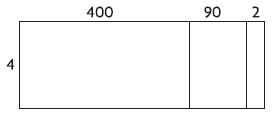
Options:
a. 16 + 36 + 8 = 60
b. 160 + 36 + 8 = 204
c. 160 + 360 + 8 = 528
d. 1,600 + 360 + 8 = 1,968
Answer:
d. 1,600 + 360 + 8 = 1,968
Explanation:
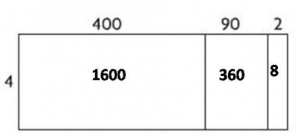
1,600 + 360 + 8 = 1,968
Question 5.
What is the sum 13,094 + 259,728?
Options:
a. 272,832
b. 272,822
c. 262,722
d. 262,712
Answer:
c. 262,722
Explanation:
13,094 + 259,728 = 262,722
Question 6.
During the 2008–2009 season, there were 801,372 people who attended the home hockey games in Philadelphia. There were 609,907 people who attended the home hockey games in Phoenix. How much greater was the home attendance in Philadelphia than in Phoenix that season?
Options:
a. 101,475
b. 191,465
c. 201,465
d. 202,465
Answer:
b. 191,465
Explanation:
801,372 – 609,907 = 191,465
Philadelphia attendance is 191,465 greater than in Phoenix that season.
Page No. 185
Question 1.
An average of 74 reports with bird counts were turned in each day in June. An average of 89 were turned in each day in July. How many reports were turned in for both months? (Hint: There are 30 days in June and 31 days in July.)
First, write the problem for June.
Type below:
__________
Answer:
Given that An average of 74 reports with bird counts was turned in each day in June.
For June Month, there are 30 days = 30 x 74 = 2,220.
Question 1.
Next, write the problem for July.
Type below:
__________
Answer:
An average of 89 reports with bird counts was turned in each day in July.
For July Month, there are 31 days = 31 x 89 = 2,759.
Question 1.
Last, find and add the two products.
____________ reports were turned in for both months.
Type below:
__________
Answer:
Given that An average of 74 reports with bird counts was turned in each day in June.
For June Month, there are 30 days = 30 x 74 = 2,220.
An average of 89 reports with bird counts was turned in each day in July.
For July Month, there are 31 days = 31 x 89 = 2,759.
Add two products to get the total number of reports that were turned in for both months.
2,220 + 2,759 = 4,979.
Question 2.
What if an average of 98 reports were turned in each day for the month of June? How many reports were turned in for June? Describe how your answer for June would be different.
______ reports
Answer:
720 more reports
Explanation:
Given that an average of 98 reports was turned in each day for the month of June.
June has 30 days.
Total number of reports were turned in for June = 30 x 98 = 2, 940.
From the above answer, 98 − 74 = 24. So, there would be 30 × 24, or 720 more reports.
Question 3.
There are 48 crayons in a box. There are 12 boxes in a carton. Mr. Johnson ordered 6 cartons of crayons for the school. How many crayons did he get?
______ crayons
Answer:
3,456 crayons
Explanation:
There are 48 crayons in a box.
There are 12 boxes in a carton.
So, 1 carton = 48 x 12 = 576 crayons.
If Mr. Johnson ordered 6 cartons of crayons for the school, 6 x 576 crayons = 3,456 crayons.
He gets 3,456 crayons.
Question 4.
Make Sense of Problems Each of 5 birdwatchers reported seeing 15 roseate spoonbills in a day. If they each reported seeing the same number of roseate spoonbills over 14 days, how many would be reported?
______ roseate spoonbills
Answer:
1,050 roseate spoonbills
Explanation:
Given that, 1 day –>5 birdwatchers reported 15 roseate spoonbills = 5 x 15 = 75 roseate spoonbills.
So, in 14 days –> 5 birdwatchers reported 75 x 14 = 1,050 roseate spoonbills.
Page No. 186
Question 5.
On each of Maggie’s bird-watching trips, she has seen at least 24 birds. If she has taken 4 of these trips each year over the past 16 years, at least how many birds has Maggie seen?
at least ______ birds
Answer:
Maggie seen 1,536 birds
Explanation:
Given that, 1 trip –> Maggie seen 24 birds.
For 1 year she goes for 4 bird-watching trips.
So, she has seen 4 x 24 = 96 birds for 1 year.
For 16 years, 16 x 96 = 1,536 birds have Maggie seen.
Question 6.
Make Sense of Problems There are 12 inches in a foot. In September, Mrs. Harris orders 32 feet of ribbon for the Crafts Club. In January, she orders 9 feet less. How many inches of ribbon does Mrs. Harris order? Explain how you found your answer.
______ inches
Answer:
660 inches
Explanation:
There are 12 inches in a foot.
In September, Mrs. Harris orders 32 feet of ribbon for the Crafts Club = 32 x 12 = 384.
In January, she orders 9 feet less = 32 – 9 = 23.
So, in January, she orders 23 x 12 = 276.
Mrs. Harris order 276 + 384 = 660 inches of ribbon in total.
(or)
9 less than 32 is 23, so I added 23 + 32 = 55.
Then, I multiplied 55 × 12 = 660.
Question 7.
Lydia is having a party on Saturday. She decides to write a riddle on her invitations to describe her house number on Cypress Street. Use the clues to find Lydia’s address.
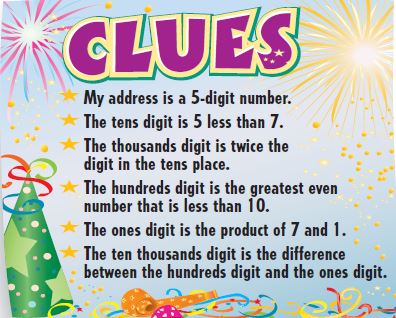
______ Cypress Street
Answer:
14827 Cypress Street
Explanation:
Given that tens digit is 5 less than 7 = 7 – 5 = 2. 2 is the tens digit.
The thousands digit is twice the digit in the tens place = 2 x 2 = 4.
The hundreds digit is the greatest even number that is less than 10 i.e, 8.
The ones digit is the product of 7 and 1 = 7 x 1 = 7.
The ten thousands digit is the difference between the hundreds digit and the ones digit. So, 8 – 7 = 1.
Add the products to get the final answer = 14827.
Lydia’s address ( house number ) is 14827 Cypress Street.
Question 8.
A school is adding 4 rows of seats to the auditorium. There are 7 seats in each row. Each new seat costs $99. What is the total cost for the new seats? Show your work.
$ ______
Answer:
$2,772
Explanation:
Given that A school is adding 4 rows of seats to the auditorium. There are 7 seats in each row.
So, 7 x 4 = 28 seats are available in an auditorium.
Each new seat costs $99.
28 x $99 = $2,772 for total cost of the new seats.
Common Core – Page No. 187
Problem Solving Multiply 2 – Digit numbers
Solve each problem. Use a bar model to help.
Question 1.
Mason counted an average of 18 birds at his bird feeder each day for 20 days. Gloria counted an average of 21 birds at her bird feeder each day for 16 days. How many more birds did Mason count at his feeder than Gloria counted at hers?
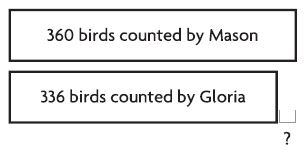
Birds counted by Mason: 18 × 20 = 360
Birds counted by Gloria: 21 × 16 = 336
Draw a bar model to compare.
Subtract. 360 – 336 = 24
So, Mason counted 24 more birds.
Answer:
Birds counted by Mason: 18 × 20 = 360
Birds counted by Gloria: 21 × 16 = 336
Draw a bar model to compare.

Subtract. 360 – 336 = 24
So, Mason counted 24 more birds.
Question 2.
The 24 students in Ms. Lee’s class each collected an average of 18 cans for recycling. The 21 students in Mr. Galvez’s class each collected an average of 25 cans for recycling. How many more cans were collected by Mr. Galvez’s class than Ms. Lee’s class?
______ more cans
Answer:
The number of cans collected by Ms. Lee’s class = 18 x 24 = 432.
The number of cans collected by Mr. Galvez’s class = 25 x 21 = 525.
Use Bar Model

Subtract. 525 – 432 = 93 more cans.
So, Mr. Galvez’s class collected 93 more cans than Ms. Lee’s class.
Question 3.
At East School, each of the 45 classrooms has an average of 22 students. At West School, each of the 42 classrooms has an average of 23 students. How many more students are at East School than at West School?
______ more students
Answer:
Students in East school = 45 x 22 = 990.
Students in West School = 42 x 23 = 966.
Use Bar Model
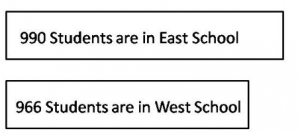
Subtract. 990 – 966 = 24.
So, East School has 24 students more than West School.
Question 4.
A zoo gift shop orders 18 boxes of 75 key rings each and 15 boxes of 80 refrigerator magnets each. How many more key rings than refrigerator magnets does the gift shop order?
______ more key rings
Answer:
Number of Key Rings = 75 x 18 = 1,350.
Number of Refrigerator Magnets= 80 x 15 = 1,200.
Use Bar Model
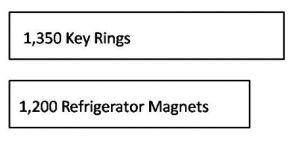
Subtract. 1,350 – 1,200 = 150.
So, key rings are 150 more than refrigerator magnets.
Common Core – Page No. 188
Lesson Check
Question 1.
Ace Manufacturing ordered 17 boxes with 85 ball bearings each. They also ordered 15 boxes with 90 springs each. How many more ball bearings than springs did they order?
Options:
a. 5
b. 85
c. 90
d. 95
Answer:
d. 95
Explanation:
Number of ball bearings = 85 x 17 = 1,445.
Number of springs = 90 x 15 = 1,350.
Use Bar Model

Subtract. 1,445 – 1,350 = 95.
So, ball bearings are 95 more than springs.
Question 2.
Elton hiked 16 miles each day on a 12-day hiking trip. Lola hiked 14 miles each day on her 16-day hiking trip. In all, how many more miles did Lola hike than Elton hiked?
Options:
a. 2 miles
b. 18 miles
c. 32 miles
d. 118 miles
Answer:
c. 32 miles
Explanation:
Hiking trip by Elton = 12 x 16 = 192.
Hiking trip by Lola = 16 x 14 = 224.
Use Bar Model
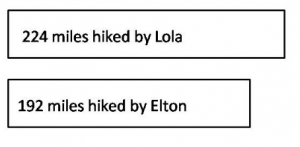
Subtract. 224 – 192 = 32.
So, the Hiking trip by Lola is 32 times more than the Hiking trip by Elton.
Spiral Review
Question 3.
An orchard has 24 rows of apple trees. There are 35 apple trees in each row. How many apple trees are in the orchard?
Options:
a. 59
b. 192
c. 740
d. 840
Answer:
d. 840
Explanation:
An orchard has 24 rows of apple trees. There are 35 apple trees in each row.
24 x 35 = 840 apple trees are in the orchard.
Question 4.
An amusement park reported 354,605 visitors last summer. What is this number rounded to the nearest thousand?
Options:
a. 354,600
b. 355,000
c. 360,000
d. 400,000
Answer:
b. 355,000
Explanation:
An amusement park reported 354,605 visitors last summer. 4,605 is close to 5,000. So, the answer is 355,000.
Question 5.
Attendance at the football game was 102,653. What is the value of the digit 6?
Options:
a. 6
b. 60
c. 600
d. 6,000
Answer:
c. 600
Explanation:
Digit 6 is at hundreds of positions. So, the answer is 6 x 100 = 600.
Question 6.
Jill’s fish weighs 8 times as much as her parakeet. Together, the pets weigh 63 ounces. How much does the fish weigh?
Options:
a. 7 ounces
b. 49 ounces
c. 55 ounces
d. 56 ounces
Answer:
d. 56 ounces
Explanation:
Let Jill’s parakeet = X.
Jill’s fish weighs 8 times as much as her parakeet = 8X.
Together, the pets weigh 63 ounces.
X + 8X = 63.
9X = 63.
X = 63/9 = 7.
So, Jill’s parakeet =7.
Jill’s fish = 7 x 8 = 56 ounces.
Review/Test – Page No. 189
Question 1.
Explain how to find 40 × 50 using mental math
Type below:
_________
Answer:
200
Explanation:
40 x 50
By using mental math
4 x 5 = 20
40 x 50 = 200
Mrs. Traynor’s class is taking a field trip to the zoo. The trip will cost $26 for each student. There are 22 students in her class.
Question 2.
Part A
Round each factor to estimate the total cost of the students’ field trip.
$ ______
Answer:
$600
Explanation:
Total cost of the students’ field trip = 22 x $26.
22 x $26
20 x $30 = $600
The total cost would be about $600.
Question 2.
Part B
Use compatible numbers to estimate the total cost of the field trip.
$ ______
Answer:
$500
Explanation:
If we use compatible numbers to estimate the total cost of the field trip.
22 x $26
20 × 25 = 500
The total cost would be about $500.
Question 2.
Part C
Which do you think is the better estimate? Explain.
Better estimate: _________
Answer:
Using rounded numbers is a better estimate. When rounded numbers are used, one estimated factor was $4 more than the actual factor and the other estimated factor was $2 that is less than the actual factor. So, the estimate should be close to the actual one. When compatible numbers are used both estimated factors were less than the actual factors. So, the product will be an underestimate.
Review/Test – Page No. 190
For numbers 3a–3e, select Yes or No to show if the answer is correct.
Question 3.
3a. 35 × 10 = 350
i. yes
ii. no
Answer:
i. yes
Explanation:
35 x 10 = 350
30 x 10 = 300.
5 x 10 = 50.
300 + 50 = 350.
Question 3.
3b. 19 × 20 = 380
i. yes
ii. no
Answer:
i. yes
Explanation:
19 × 20 = 380
19 x 20 = 19 x 2 tens.
19 x 20 = 38 tens = 380.
Question 3.
3c. 12 × 100 = 120
i. yes
ii. no
Answer:
ii. no
Explanation:
12 x 100 = 120.
10 x 100 = 1000
2 x 100 = 200.
1000 + 200 = 1200.
Question 3.
3d. 70 × 100 = 7,000
i. yes
ii. no
Answer:
i. yes
Explanation:
70 x 100 = 7,000
100 x 7 tens = 700 tens = 7,000
Question 3.
3e. 28 × 30 = 2,100
i. yes
ii. no
Answer:
ii. no
Explanation:
28 × 30
20 x 30 = 600
8 x 30 = 240
600 + 240 = 840
Question 4.
There are 23 boxes of pencils in Mr. Shaw’s supply cabinet. Each box contains 100 pencils. How many pencils are in the supply cabinet?
_____ penciles
Answer:
2,300 pencils
Explanation:
23 x 100 = 2,300 pencils are in the supply cabinet.
Question 5.
Which would provide a reasonable estimate for each product? Write the estimate beside the product. An estimate may be used more than once
23 × 38 __________
31 × 32 __________
46 × 18 __________
39 × 21 __________
Answer:
23 × 38 –> 25 x 40
31 x 32 –> 30 × 30
46 × 18 –> 50 × 20
39 × 21 –> 25 × 40
Explanation:
23 × 38; 23 is close to 25; 38 is close to 40.
So, the estimated product is 25 x 40
31 x 32; 31 is close to 30; 32is close to 30.
So, the estimated product is 30 × 30
46 × 18; 46 is close to 50; 18 is close to 20.
So, the estimated product is 50 × 20
39 × 21; 39 is close to 40; 21 is close to 25.
So, the estimated product is 25 × 40
Question 6.
There are 26 baseball teams in the league. Each team has 18 players. Write a number sentence that will provide a reasonable estimate for the number of players in the league. Explain how you found your estimate.
Type below:
__________
Answer:
There are 26 baseball teams in the league. Each team has 18 players.
26 x 18
25 x 20
We Rounded each factor to its close factor, then simplified the multiplication.
Question 7.
The model shows 48 × 37. Write the partial products.
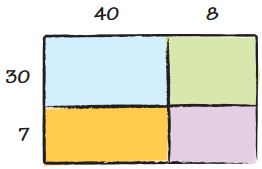
Type below:
__________
Answer:
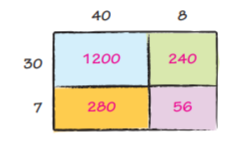
Partial Products are 1200, 240, 280, 56
Review/Test – Page No. 191
Question 8.
Jess made this model to find the product 32 × 17. Her modelis incorrect.
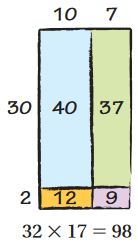
Part A
What did Jess do wrong?
Type below:
__________
Answer:
Jess added the numbers in the model instead of multiplying.
Question 8.
Part B
Redraw the model so that it is correct.

Type below:
__________
Answer:

Question 8.
Part C
What is the actual product 32 × 17?
______
Answer:
544
Explanation:
32 × 17
10 x 32 = 320
7 x 32 = 224
320 + 224 = 544.
Question 9.
Tatum wants to use partial products to find 15 × 32. Write the numbers in the boxes to show 15 × 32.

Type below:
__________
Answer:
![]()
Review/Test – Page No. 192
Question 10.
Which product is shown by the model? Write the letter of the product on the line below the model.
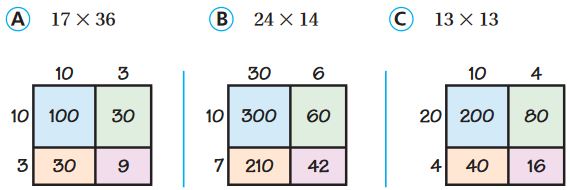
Type below:
__________
Answer:

C A B
10 + 3 = 13
10 + 3 = 13
13 x 13
2. 10 + 7 = 17
30 + 6 = 36
17 x 36
3. 20 + 4 = 24
10 + 4 = 14
24 x 14
Question 11.
Mrs. Jones places 3 orders for school T-shirts. Each order has 16 boxes of shirts and each box holds 17 shirts. How many T-shirts does Mrs. Jones order? Use partial products to help you.
Type below:
__________
Answer:
816 T-shirts
Explanation:
Mrs. Jones places 3 orders for school T-shirts. Each order has 16 boxes of shirts and each box holds 17 shirts.
Each box has 17 shirts.
16 boxes = 16 x 17 = 272.
Each order = 16 boxes = 272 shirts.
3 orders = 3 x 272 = 816 shirts.
Mrs. Jones order 816 T-shirts.
Question 12.
Write the unknown digits. Use each digit exactly once.
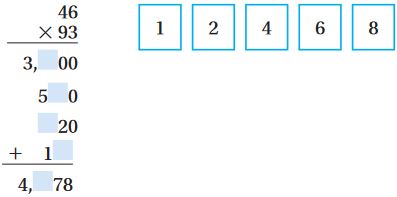
Type below:
__________
Answer:

90 x 40 = 3,600
90 x 6 = 540
3 x 40 = 120
3 x 6 = 18.
3,600 + 540 + 120 + 8 = 4,278.
Question 13.
Mike has 16 baseball cards. Niko has 17 times as many baseball cards as Mike does. How many baseball cards does Niko have?
________ baseball cards
Answer:
272 baseball cards
Explanation:
Mike has 16 baseball cards. Niko has 17 times as many baseball cards as Mike does.
Niko have 16 x 17 = 272 baseball cards.
Question 14.
Multiply.
36 × 28 = ________
Answer:
1,008
Explanation:
36 x 28
20 x 30 = 600
20 x 6 = 120
8 x 30 = 240
8 x 6 = 48
600 + 120 + 240 + 48 = 1,008
Review/Test – Page No. 193
Question 15.
A farmer planted 42 rows of tomatoes with 13 plants in each row. How many tomato plants did the farmer grow?
42 × 13 = ______ tomato plants
Answer:
420 + 126 = 546 tomato plants
Explanation:
42 × 13
10 x 42 = 420
3 x 42 = 126
420 + 126 = 546 tomato plants
Question 16.
Select another way to show 25 × 18. Mark all that apply.
Options:
a. (20 × 10) + (20 × 8) + (5 × 10) + (5 × 8)
b. (25 × 20) + (25 × 5) + (25 × 10) + (25 × 8)
c. (20 × 18) + (5 × 10) + (5 × 8)
d. (25 × 10) + (25 × 8)
e. (25 × 20) + (25 × 5)
Answer:
a. (20 × 10) + (20 × 8) + (5 × 10) + (5 × 8)
c. (20 × 18) + (5 × 10) + (5 × 8)
d. (25 × 10) + (25 × 8)
Explanation:
25 × 18
10 x 25 = 250
8 x 25 = 200
250 + 200 = 450.
a. (20 × 10) + (20 × 8) + (5 × 10) + (5 × 8) = 200 + 160 + 50 + 40 = 450
b. (25 × 20) + (25 × 5) + (25 × 10) + (25 × 8) = 500 + 125 + 250 + 200 = 1,075
c. (20 × 18) + (5 × 10) + (5 × 8) = 360 + 50 + 40 = 450
d. (25 × 10) + (25 × 8) = 250 + 200 = 450
e. (25 × 20) + (25 × 5) = 500 + 125 = 625
Question 17.
Terrell runs 15 sprints. Each sprint is 65 meters. How many meters does Terrell run? Show your work.
______ meters
Answer:
975 meters
Explanation:
Terrell run 15 x 65 = 975 meters.
Question 18.
There are 3 new seats in each row in a school auditorium. There are 15 rows in the auditorium. Each new seat cost $74. What is the cost for the new seats? Explain how you found your answer.
$ ______
Answer:
$3,330
Explanation:
Given that There are 3 new seats in each row in a school auditorium. There are 15 rows in the auditorium. Each new seat cost $74.
So, 3 x 15 = 45 seats are available in an auditorium.
Each new seat costs $74.
45 x $74 = $3,330 for total cost of the new seats.
Question 19.
Ray and Ella helped move their school library to a new building. Ray packed 27 boxes with 25 books in each box. Ella packed 23 boxes with 30 books in each box. How many more books did Ella pack? Show your work.
______ books
Answer:
15 books
Explanation:
Ray packed 27 x 25 = 675 books.
Ella packed 23 x 30 = 690 books
Ella packed 690 – 675 = 15 books more than Ray.
Review/Test – Page No. 194
Question 20.
Julius and Walt are finding the product of 25 and 16.
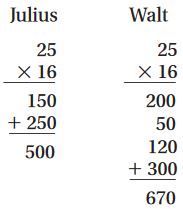
Part A
Julius’ answer is incorrect. What did Julius do wrong?
Type below:
__________
Answer:
Julius multiplied 25 by 10 and then multiplied 25 by 6 correctly. He added the two partial products incorrectly.
Question 20.
Part B
What did Walt do wrong?
Type below:
__________
Answer:
Walt multiplied 6 by 5 and got 300 instead of 30
Question 20.
Part C
What is the correct product?
Type below:
__________
Answer:
25 x 16 = 400
Question 21.
A clothing store sells 26 shirts and 22 pairs of jeans. Each item of clothing costs $32.
Part A
What is a reasonable estimate for the total cost of the clothing?
Show or explain how you found your answer.
$ ______
Answer:
$1500
Explanation:
A clothing store sells 26 shirts and 22 pairs of jeans. 26 + 22 = 48 clothes.
Each item of clothing costs $32.
48 x $32
50 x $30 = $1500
Question 21.
Part B
What is the exact answer for the total cost of the clothing? Show or explain how you found your answer.
$ ______
Answer:
$1,536
Explanation:
48 x $32
40 x $32 = $1,280
8 x $32 = $256
$1,280 + $256 = $1,536
Page No. 199
Question 1.
A restaurant has 68 chairs. There are six chairs at each table. About how many tables are in the restaurant?
Estimate. 68 ÷ 6
Think: What number times 6 is about 68?
10 × 6 = ___
11 × 6 = ___
12 × 6 = ___
68 is closest to ______, so the best estimate is about _______ tables are in the restaurant.
Type below:
__________
Answer:
68 is close to 70 and 6 is close to 5.
So, 70/5 = 12.
10 × 6 = __60_
11 × 6 = _66__
12 × 6 = _72__
68 is closest to ___66___, so the best estimate is about 11 x 6 = 66 tables are in the restaurant.
Find two numbers the quotient is between. Then estimate the quotient.
Question 2.
41 ÷ 3
between _______ and _______
Answer:
between 13 and 14
about 14
Explanation:
13 x 3 = 39; 14 x 3 = 42.
The quotient of 41 ÷ 3 is between 13 and 14.
Question 3.
192 ÷ 5
between _______ and _______
Answer:
between 30 and 40
about 40
Explanation:
30 x 5 = 150; 40 x 5 = 200.
The quotient of 192 ÷ 5 is between 30 and 40.
Find two numbers the quotient is between. Then estimate the quotient.
Question 4.
90 ÷ 7
between _______ and _______
Answer:
between 12 and 13
about 13
Explanation:
12 x 7 = 84; 13 x 7 = 91.
The quotient of 90 ÷ 7 is between 12 and 13.
Question 5.
67 ÷ 4
between _______ and _______
Answer:
between 16 and 17
about 17
Explanation:
16 x 4 = 64; 17 x 4 = 68.
The quotient of 67 ÷ 4 is between 16 and 17.
Question 6.
281 ÷ 9
between _______ and _______
Answer:
between 30 and 40
about 30
Explanation:
30 x 9 = 270; 40 x 9 = 360.
The quotient of 281 ÷ 9 is between 30 and 40.
Question 7.
102 ÷ 7
between _______ and _______
Answer:
between 14 and 15
about 15
Explanation:
14 x 7 = 98; 15 x 7 = 105.
The quotient of 102 ÷ 7 is between 14 and 15.
Question 8.
85 ÷ 6
between _______ and _______
Answer:
between 14 and 15
about 14
Explanation:
14 x 6 = 84; 15 x 6 = 90.
The quotient of 85 ÷ 6 is between 14 and 15.
Question 9.
220 ÷ 8
between _______ and _______
Answer:
between 20 and 30
about 30
Explanation:
20 x 8 = 160; 30 x 8 = 240.
The quotient of 220 ÷ 8 is between 20 and 30.
Decide whether the actual quotient is greater than or less than the estimate given. Write < or >.
Question 10.
83 ÷ 8 _______ 10
Answer:
>
Explanation:
83 ÷ 8 = 10.375 > 10
Question 11.
155 ÷ 4 _______ 40
Answer:
<
Explanation:
155 ÷ 4 = 38.75 < 40
Question 12.
70 ÷ 6 _______ 11
Answer:
>
Explanation:
70 ÷ 6 = 11.666 > 11
Question 13.
What’s the Question? A dolphin’s heart beats 688 times in 6 minutes. Answer: about 100 times.
Type below:
__________
Answer:
About how many times does a dolphin’s heart beats in 1 minute?
Question 14.
Analyze A mother bottlenose ate about 278 pounds of food in one week. About how much food did she eat in a day?
about _____ pounds
Answer:
about 40 pounds
Explanation:
278 ÷ 7
The quotient of 278 ÷ 7 is between 39 and 40.
Question 15.
Tanya has $42 to spend at the Dolphin Island store. T-shirts sell for $7 each and a pair of sunglasses sells for $6. Tanya buys 3 T-shirts. How many pairs of sunglasses can she buy with the amount of money she has left?
_____ pairs of sunglasses
Answer:
3 pairs of sunglasses
Explanation:
Given that Tanya has $42 to spend at the Dolphin Island store. T-shirts sell for $7 each and a pair of sunglasses sell for $6.
Tanya buys 3 T-shirts = 3 x $7 = $21.
pair of sunglasses = $42 – $21 = $21.
1 pair of sunglasses sells for $6.
So, $21 ÷ $7 = 3.
3 pairs of sunglasses can Tanya buy with the amount of money she has left.
Page No. 200
Question 16.
If a bottlenose dolphin can eat 175 pounds of fish, squid, and shrimp in a week, about how many pounds of food does it eat in a day? Milo says the answer is about 20 pounds. Leah says the answer is about 30 pounds. Who is correct? Explain.

________
Answer:
The bottlenose dolphin can eat 25 pounds for 1 day.
Both answers are correct. Because the 25 pounds is in between 20 and 30 pounds.
Explanation:
1 week = 7 days.
The bottlenose dolphin can eat 175 pounds for 7 days.
For 1 day = 175 ÷ 7 = 25 pounds.
The bottlenose dolphin can eat 25 pounds for 1 day.
Both answers are correct. Because the 25 pounds is in between 20 and 30 pounds.
Question 17.
Four families went out for lunch. The total food bill came to $167. The families also left a $30 tip for the waitress. If each family spent the same amount, about how much did each family spend on dinner? Explain how you found your answer.
$ ______
Answer:
$98.5
Explanation:
Four families went out for lunch. The total food bill came to $167. The families also left a $30 tip for the waitress.
So, total amount = $167 + $30 = $197.
If each family spent the same amount = $197 ÷ 2 = $98.5
Each family spent $98.5.
Question 18.
There are 6 showings of a film about Van Gogh at the Art Museum. A total of 459 people saw the film. The same number of people were at each showing. About how many people were at each showing? Circle the numbers the quotient is between. Then explain how you found your answer.
40 50 60 70 80
Type below:
_________
Answer:
40 50 60 70 80
I found multiples of 6 that 459 is between. 70 × 6 = 420 and 80 × 6 = 480. Since 459 is closer to 480, 459 ÷ 6 is about 80.
Conclusion
Hope the data shared about Go Math Grade 4 Answer Key Chapter 3 Multiply 2- Digit Number has helped you in your preparation. If you feel any learning is missing do give us your suggestions and we will consider them if possible. Just keep on visiting our site to get the latest update on Grade 4 Go Math HMH Answer Keys for other chapters as well.
